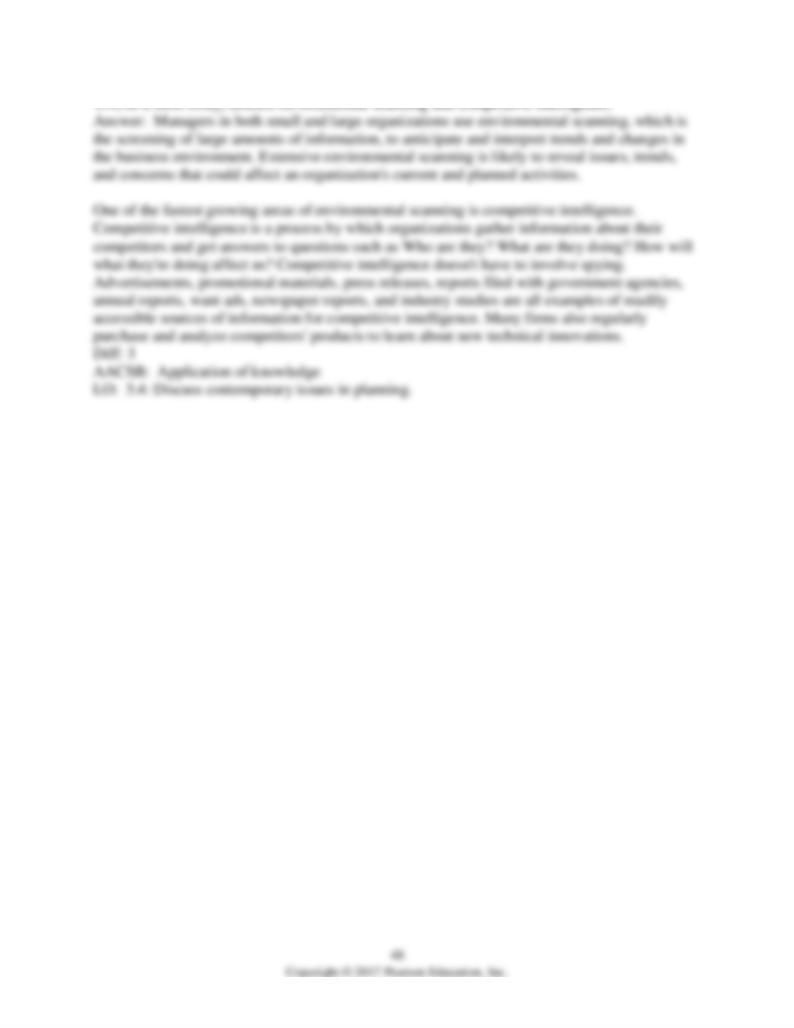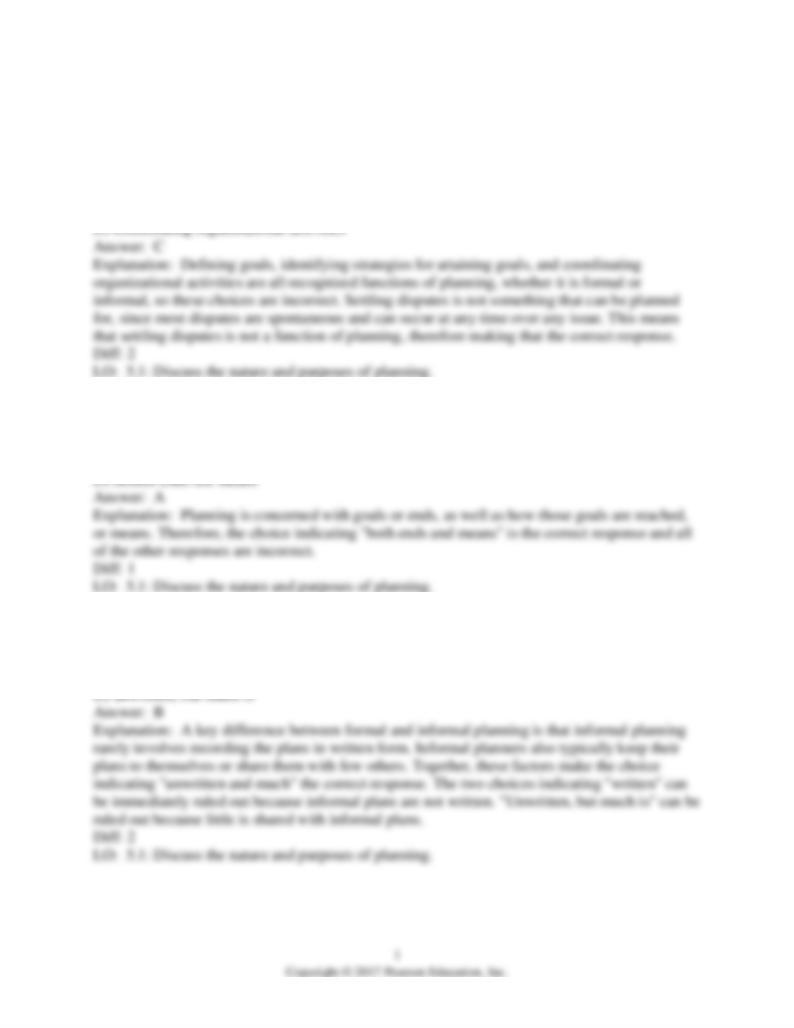
Fundamentals of Management, 10e (Robbins)
Chapter 5 Foundations of Planning
1) Which of the following is NOT a function of planning?
A) defining goals
B) identifying a strategy for attaining goals
C) settling disputes between employees
2) Planning is concerned with ________.
A) both ends and means
B) ends only
C) means only
3) In informal planning, goals are usually ________ shared with others in the organization.
A) written, but little is
B) unwritten, and little is
C) written, and much is
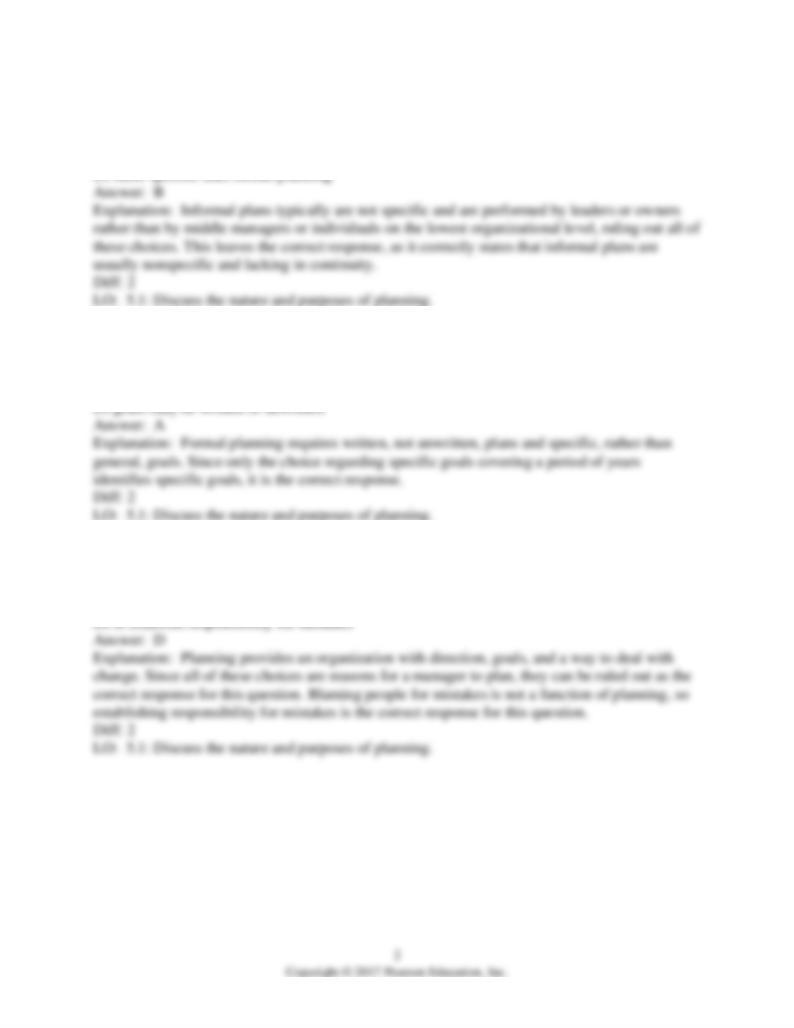
4) Informal planning is ________.
A) always performed at the lowest organizational level
B) general and usually lacks continuity
C) performed exclusively by middle managers
5) In formal planning, ________.
A) specific goals covering a period of years are defined
B) to maximize flexibility, specific goals are never spelled out
C) very broad general goals are developed
6) Which of the following is NOT a reason for managers to plan?
A) to give direction to an organization
B) to deal with change
C) to establish goals
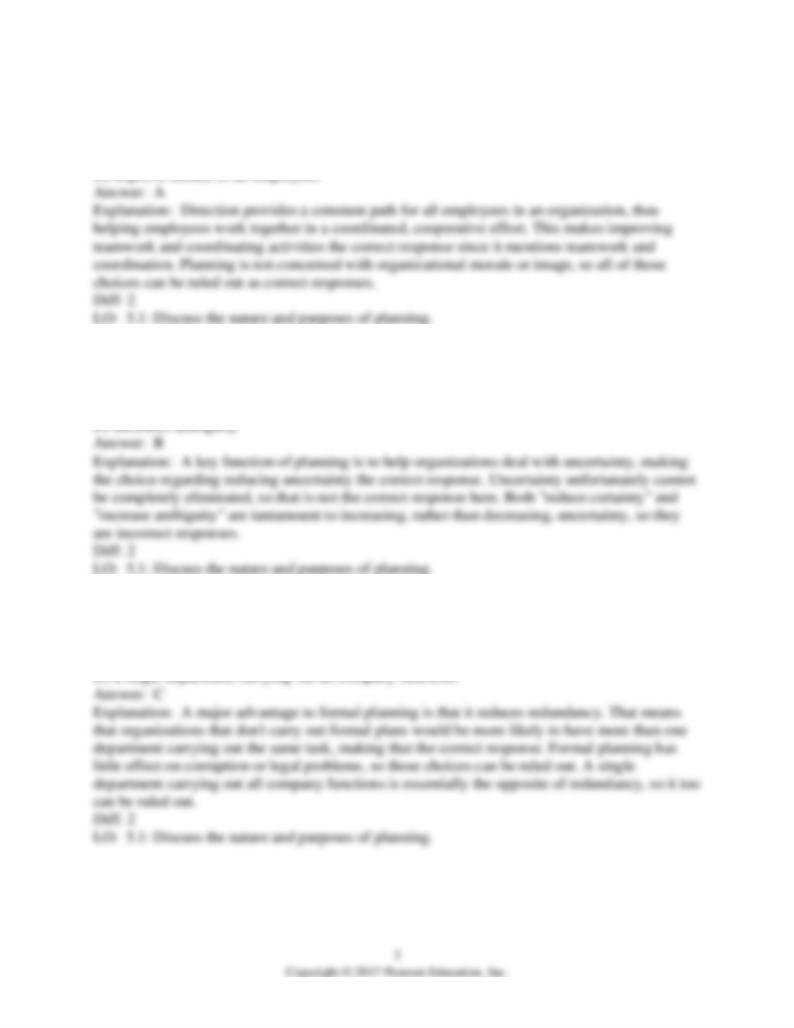
7) Planning gives organizations direction that primarily helps them ________.
A) improve teamwork and coordinate activities
B) improve their image in the business community
C) improve morale of middle managers
8) Planning gives organizations a way to deal with change that ________.
A) eliminates all uncertainty
B) reduces uncertainty
C) reduces certainty
9) Organizations that don't formally plan may be more likely to have ________.
A) corrupt managers
B) legal problems
C) multiple departments performing the same task
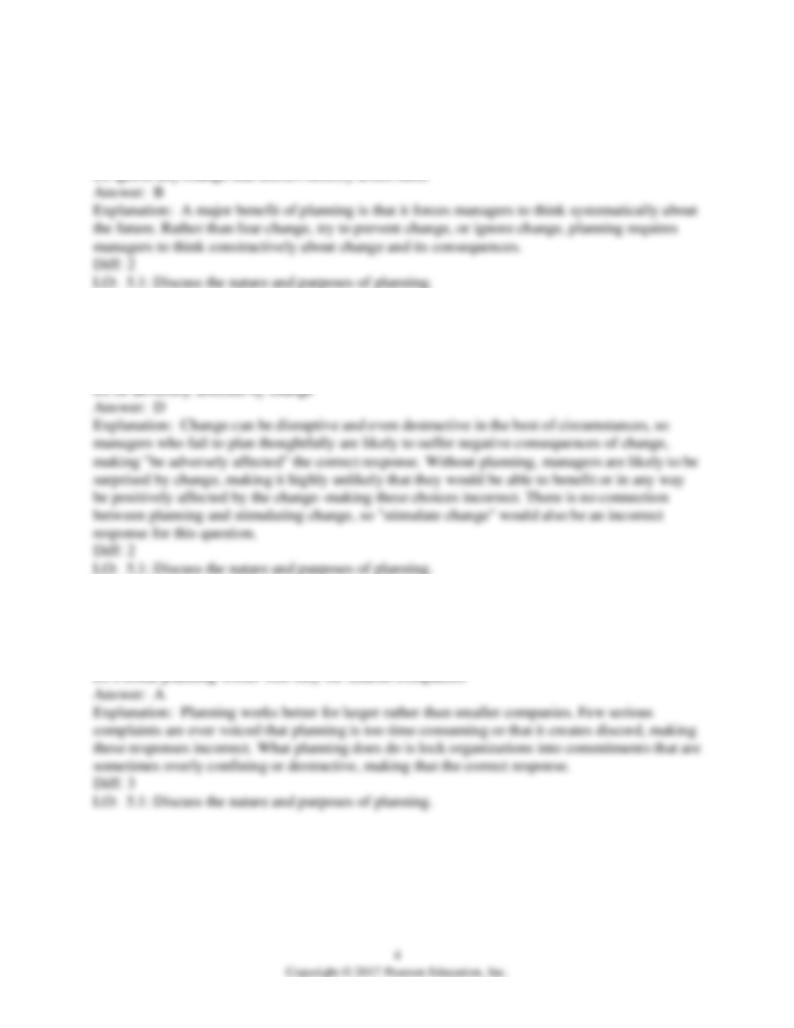
10) One effect of planning on managers is that it forces them to ________.
A) fear change
B) anticipate and consider the effect of change
C) work to prevent change
11) Managers who fail to plan may ________.
A) take advantage of change
B) stimulate change
C) be positively affected by change
12) Which of the following is a frequently cited criticism of formal planning?
A) Plans lock organizations into rigid goals and timetables.
B) Plans take too long to create.
C) Plans create resentment within different levels of the organization.
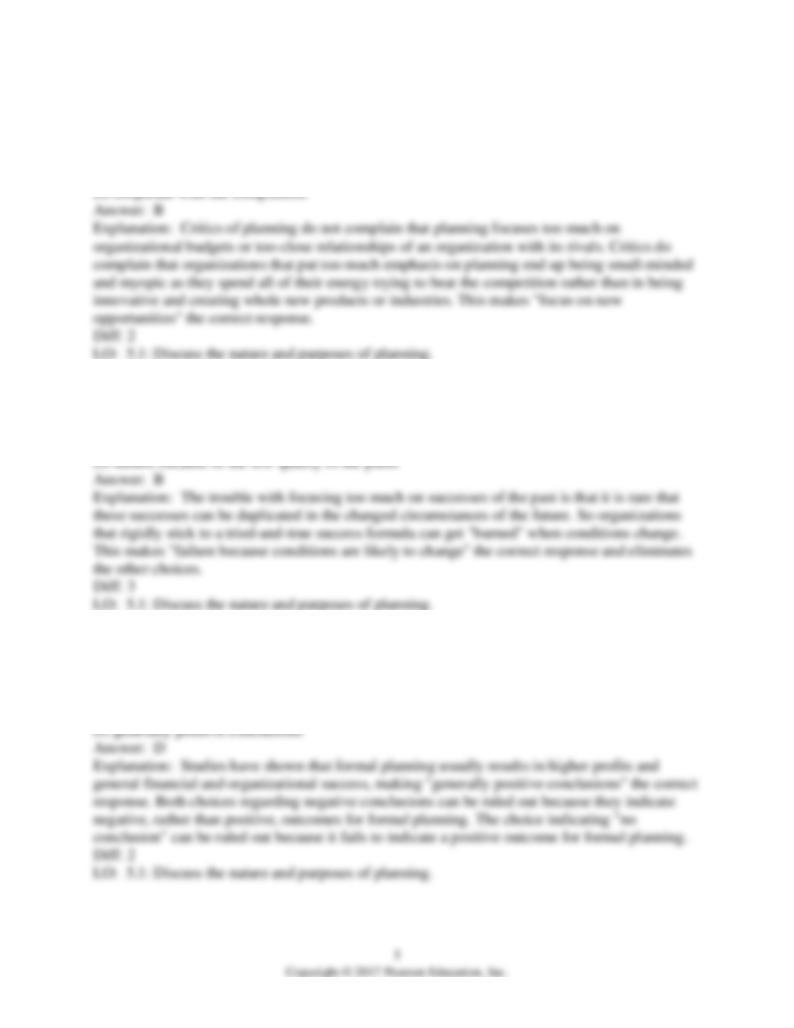
13) One criticism of formal planning is that it focuses on how to beat the competition rather than
how to ________.
A) have cordial relationships with the competition
B) focus on new opportunities
C) balance the organization's budget
14) Failing to discard successful plans from the past is likely to lead to ________.
A) more success because conditions are unlikely to change in the future
B) failure because conditions are likely to change in the future
C) success because of the high quality of the plans
15) Studies of performance in organizations that plan have reached ________ with respect to the
benefits of formal planning.
A) somewhat negative conclusions
B) no conclusion
C) extremely negative conclusions
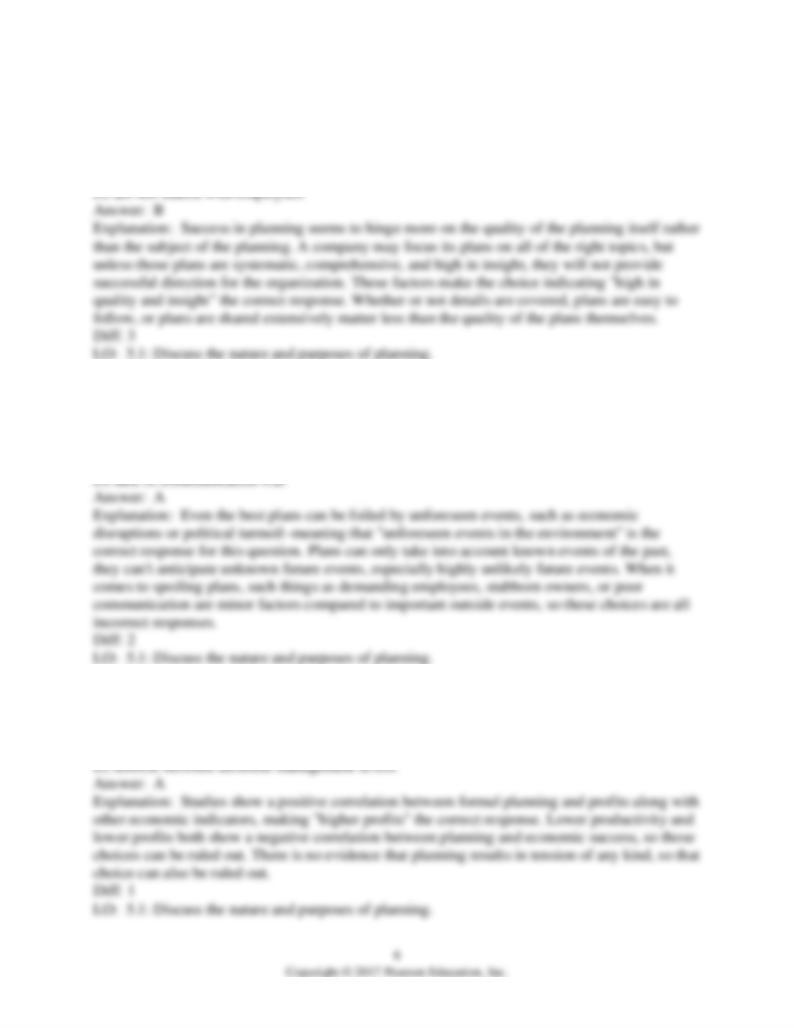
16) Studies of planning show that the key to successful planning is to make sure that the plans
________.
A) cover every possible detail
B) are high in quality and insight
C) are exceedingly simple to follow
17) In studies in which formal planning did not lead to higher performance, ________ usually
the culprit.
A) unforeseen events in the environment were
B) demanding employees were
C) stubborn ownership was
18) Formal planning typically leads to which of the following?
A) higher profits
B) lower productivity
C) higher sales, but lower profits
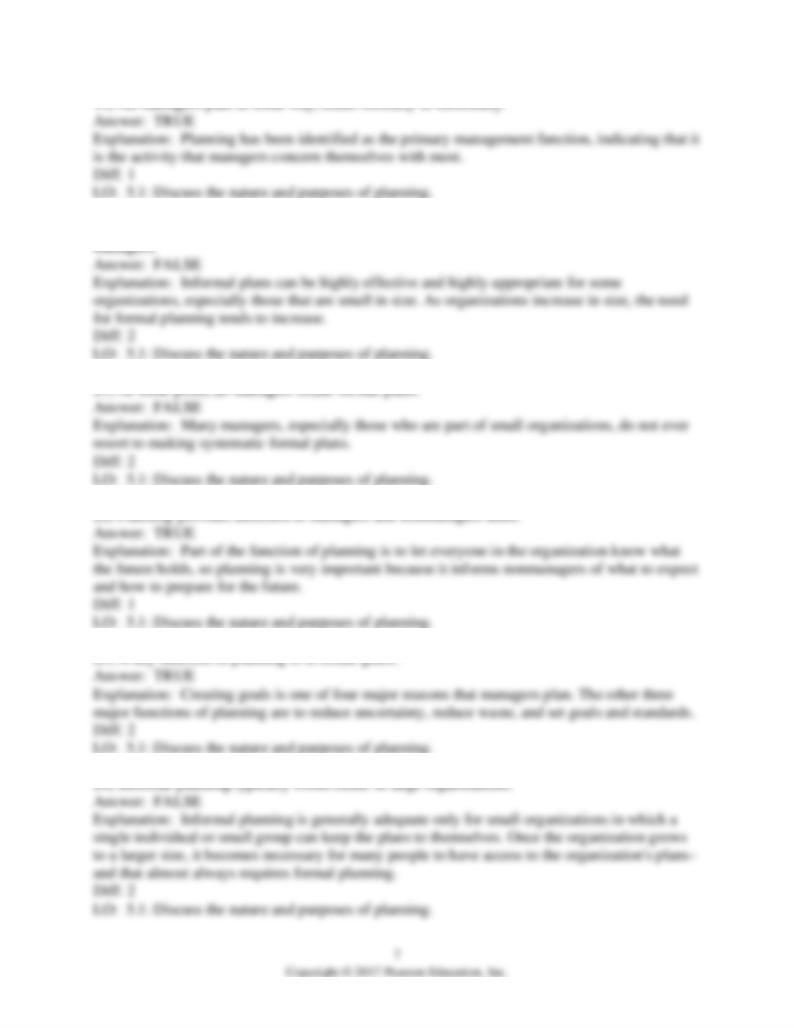
20) Informal plans are not recognized as true organizational plans and are rarely carried out by
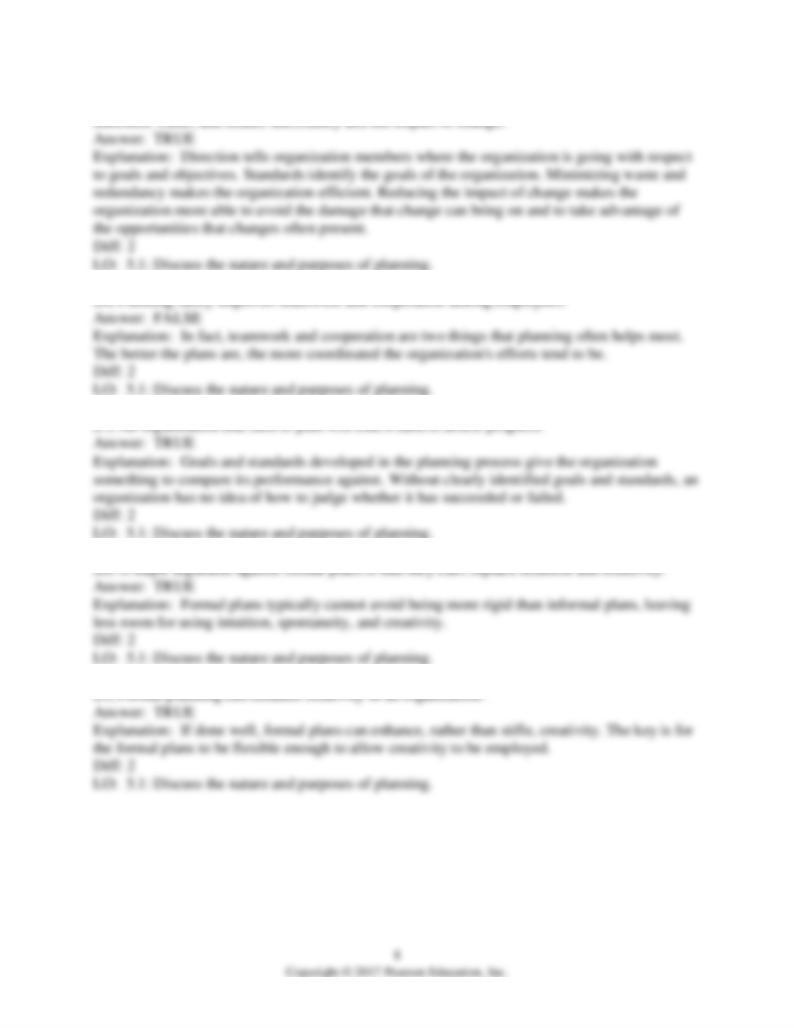
25) The four reasons that organizations plan are to establish coordinated effort, set standards,
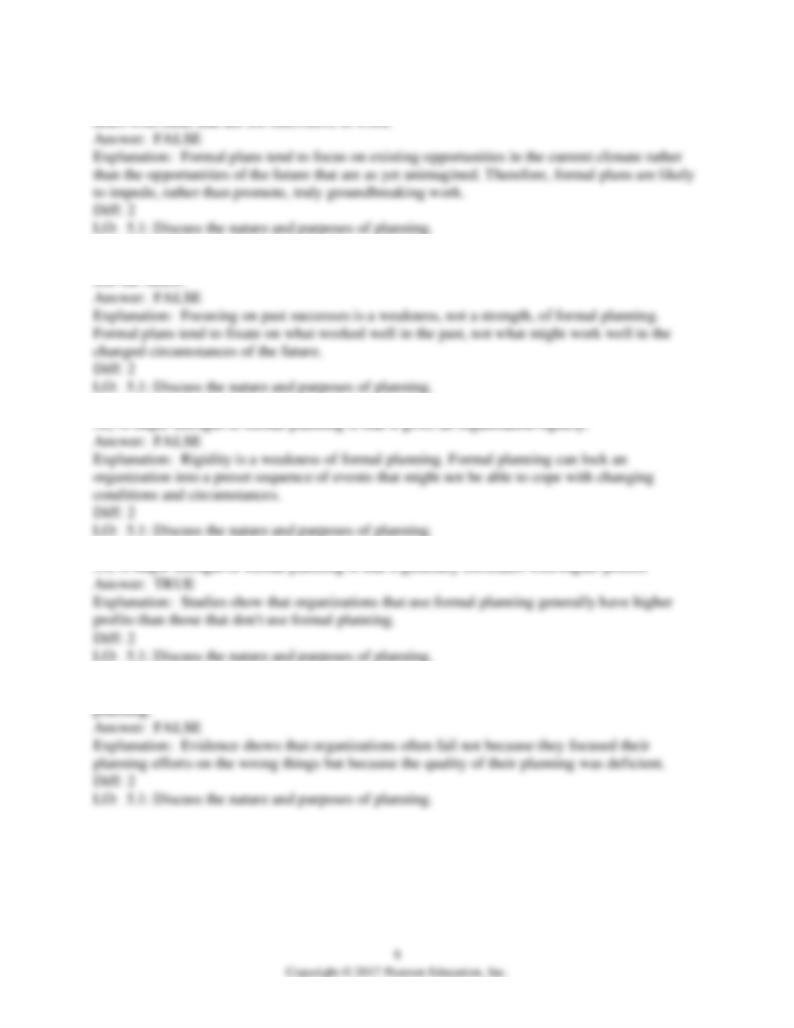
30) A criticism of formal planning is that it focuses too much on groundbreaking visions and
31) A major strength of formal planning is that it reinforces past successes and incorporates them
34) Successful planning depends more on whether managers plan than on the quality of their
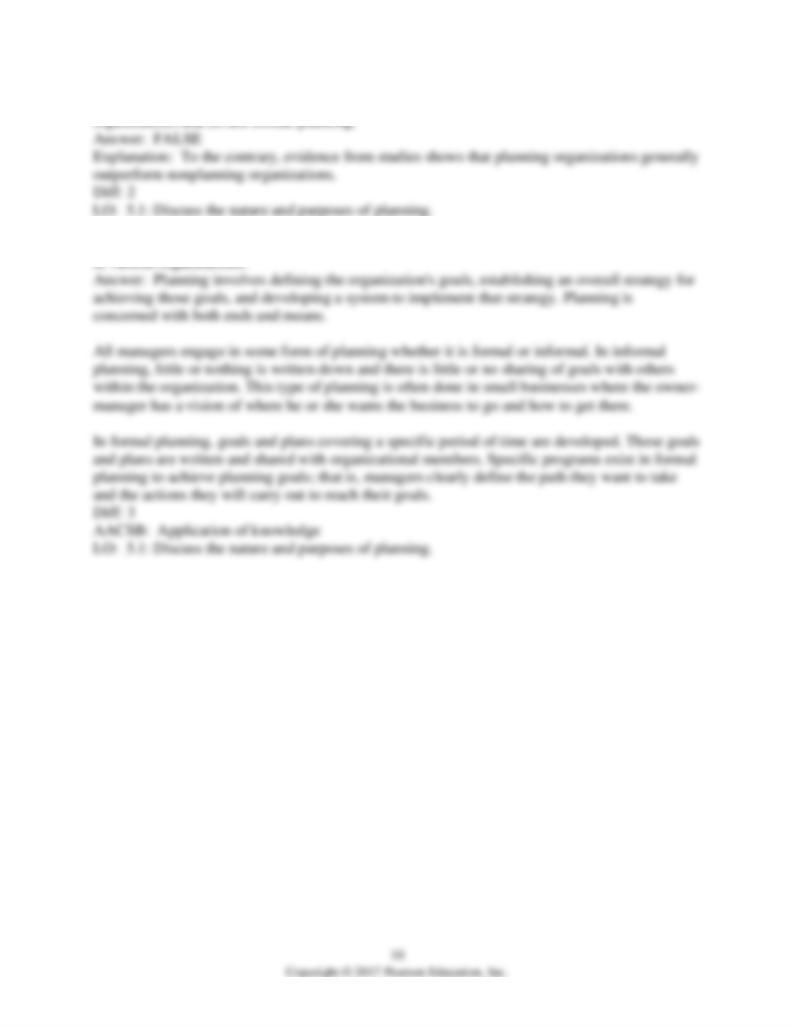
35) Research indicates that organizations that don't use formal planning always outperform
36) In a short essay, define planning and compare formal and informal planning as they are used
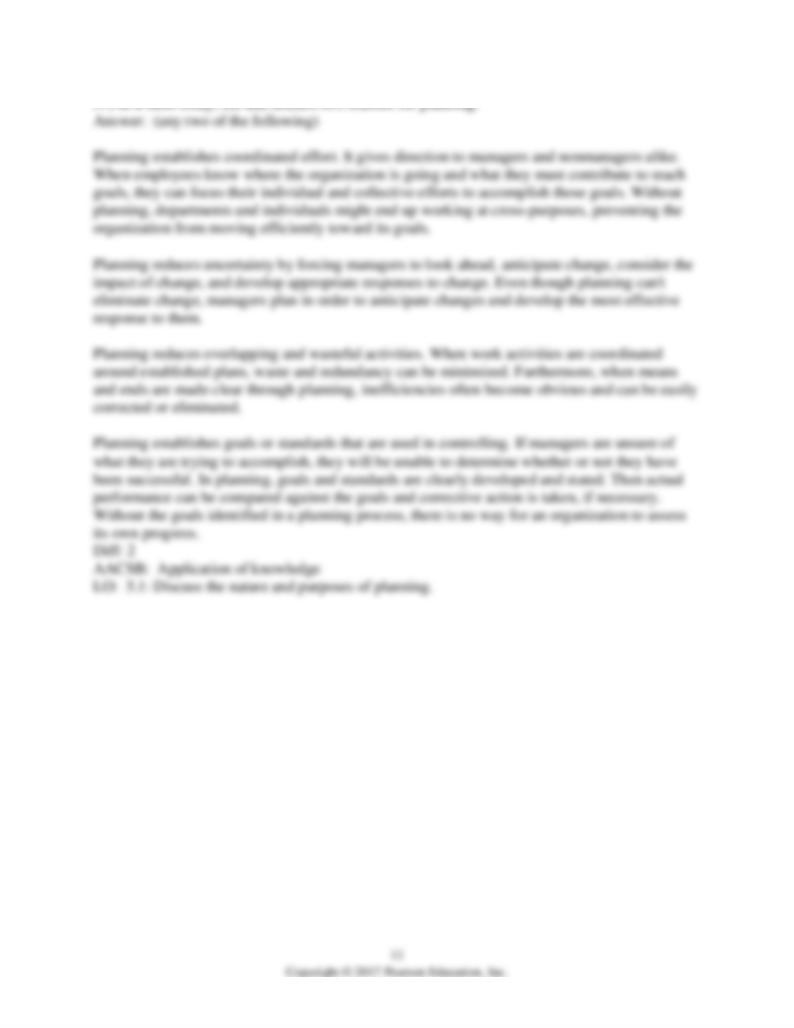
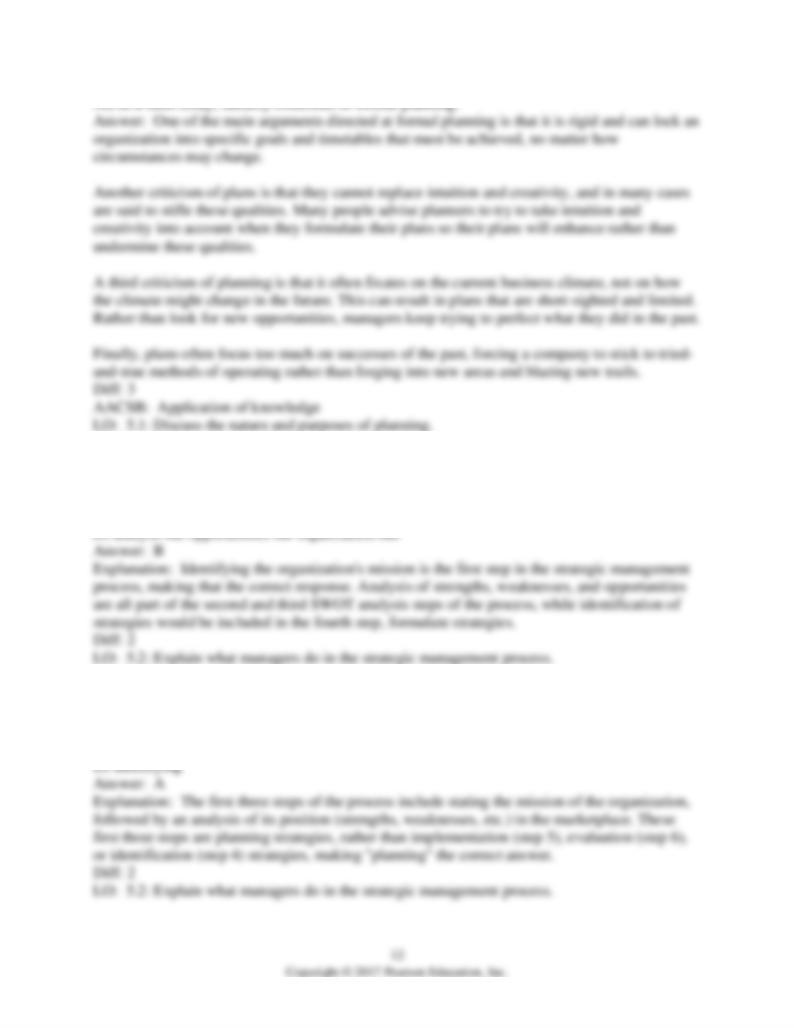
39) The first step in the six-step strategic management process is to ________.
A) analyze the organization's strengths and weaknesses
B) identify the organization's mission
C) identify feasible strategies
40) The first three steps of the strategic management process involve ________ strategies.
A) planning
B) implementing
C) evaluating
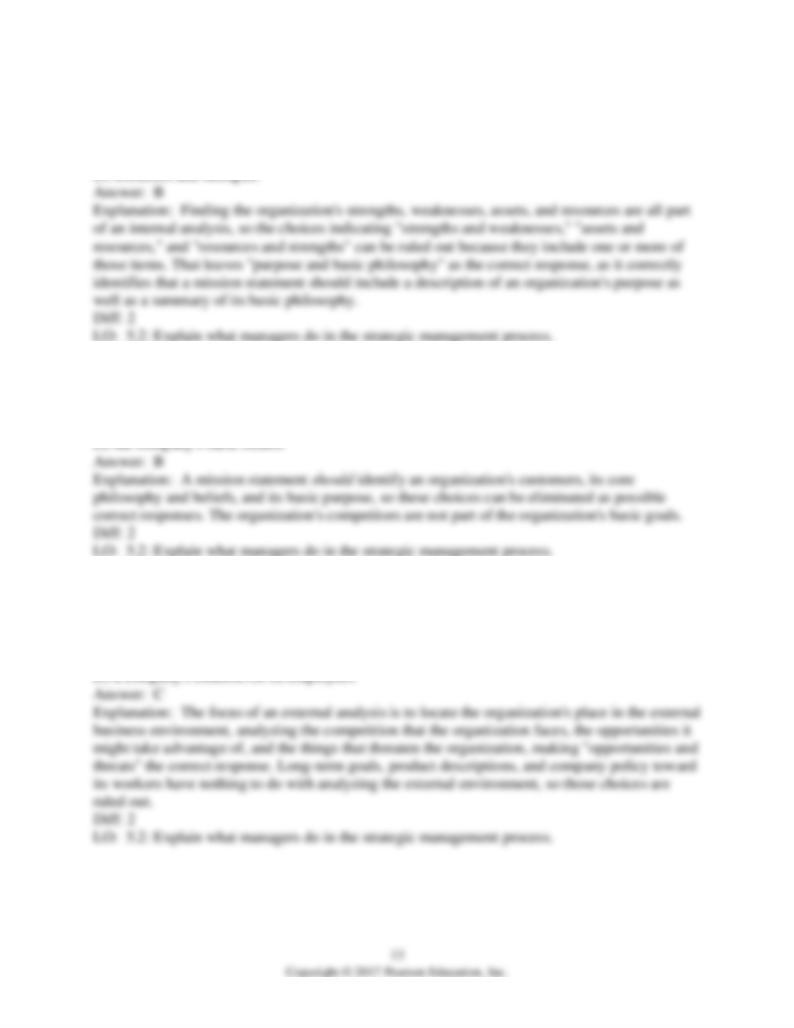
41) A mission statement includes identification of an organization's ________.
A) strengths and weaknesses
B) purpose and basic philosophy
C) assets and resources
42) A mission statement does NOT include which of the following?
A) the customers of a company
B) major competitors
C) why the company is in business and what it hopes to accomplish
43) An external analysis, the second step of the strategic management process, helps identify
________.
A) the products that a company makes
B) the long-term goals of a company
C) a company's opportunities and threats
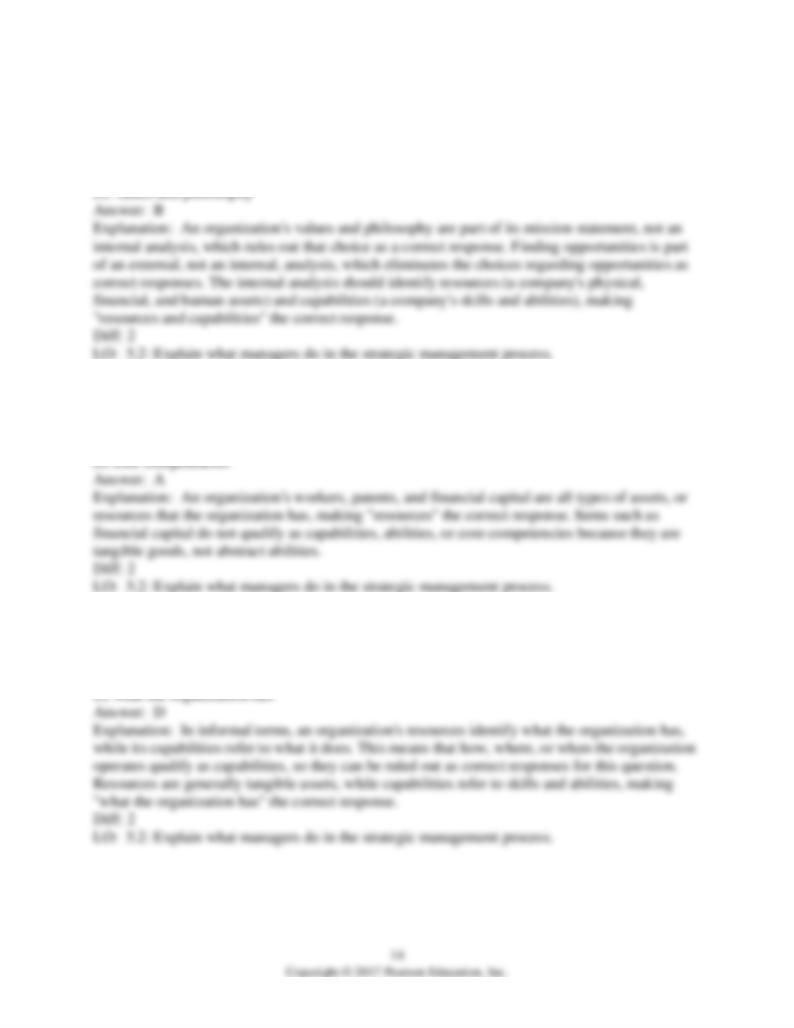
44) An internal analysis, the third step of the strategic management process helps identify
________.
A) opportunities and threats
B) resources and capabilities
C) opportunities and possibilities
45) Which term refers to an organization's capital, workers, and patents?
A) resources
B) capabilities
C) abilities
46) An organization's resources identify ________.
A) how the organization gets things done
B) where the organization operates
C) when the organization operates
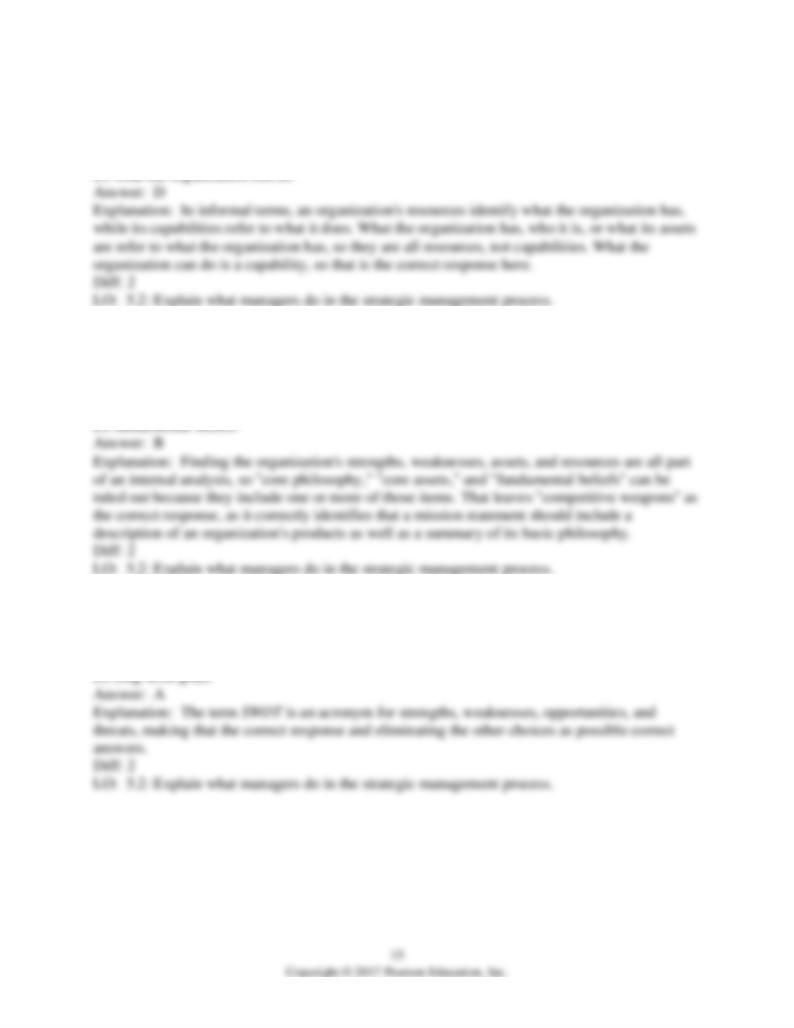
47) An organization's capabilities identify ________.
A) what the organization knows
B) who the organization is
C) assets that the organization can rely on
48) Together, an organization's resources and core competencies make up which of the
following?
A) core philosophy
B) competitive weapons
C) core assets
49) SWOT analysis identifies and analyzes an organization's ________.
A) strengths, weaknesses, opportunities, and threats
B) strategy for competing in the market
C) human resource assets
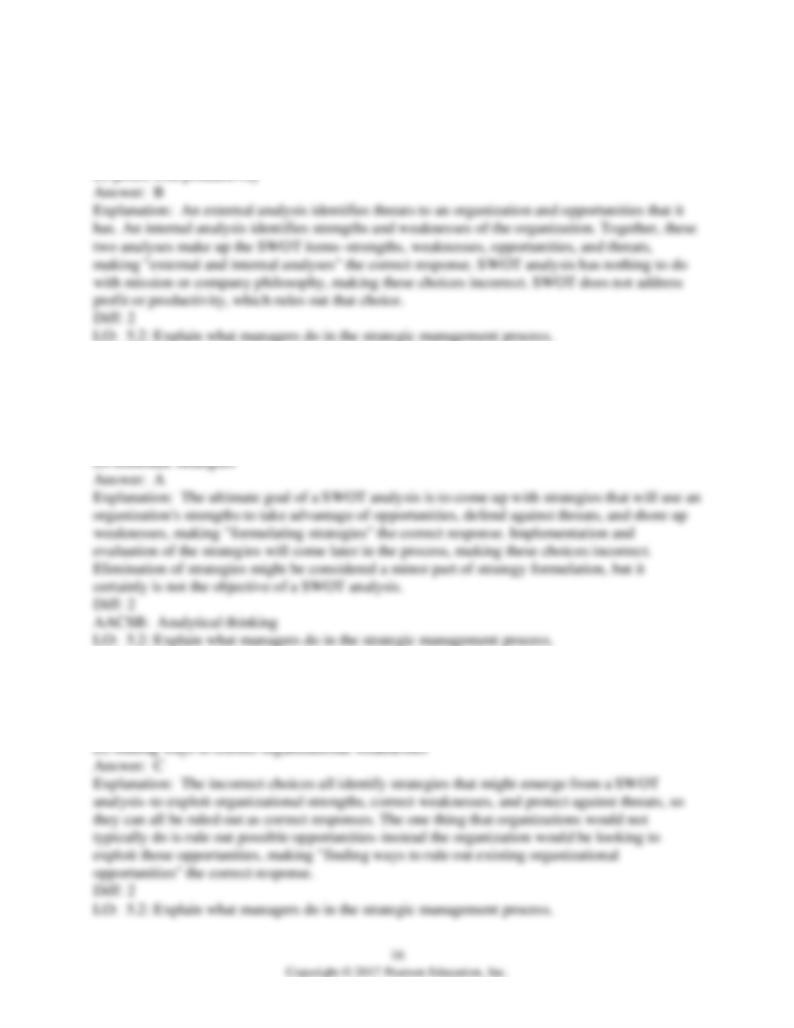
50) SWOT analysis combines ________.
A) a company's mission with its goals
B) external and internal analyses
C) a company's philosophy with its ethics
51) Once SWOT analysis is complete, managers ________ to address the issues that came up
during the analysis.
A) formulate strategies
B) implement strategies
C) evaluate strategies
52) Which of the following do managers NOT typically use to formulate strategies?
A) finding ways to exploit the organization's strengths
B) finding ways to protect the organization from external threats
C) finding ways to rule out existing organizational opportunities
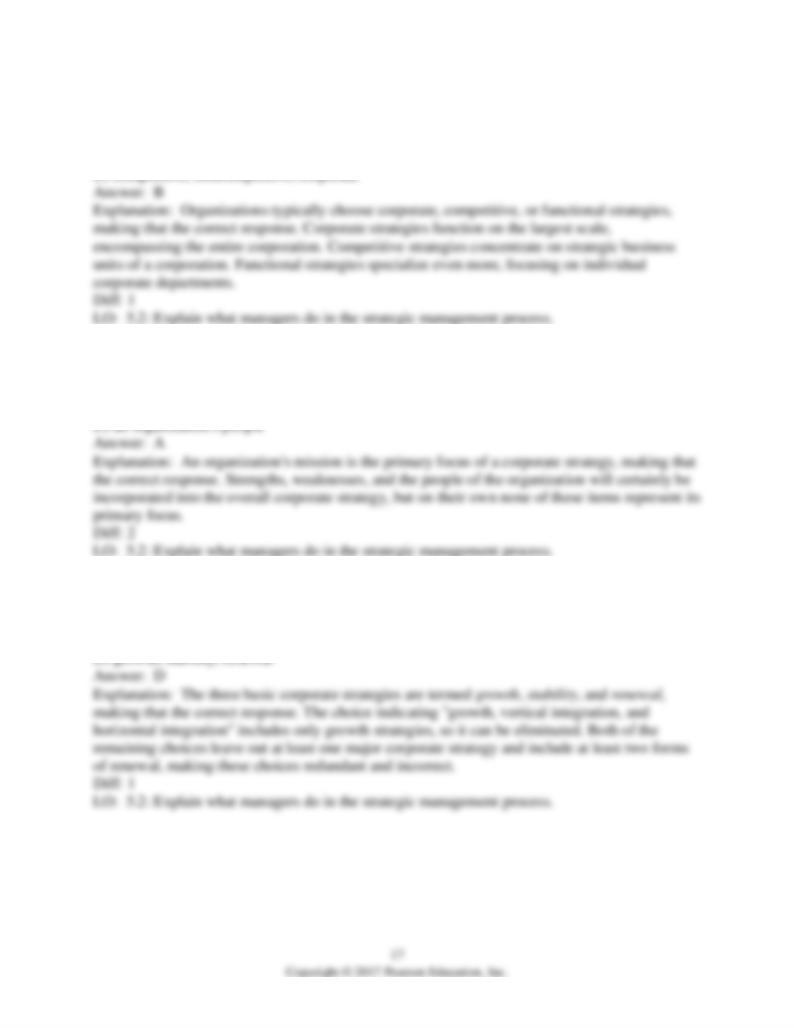
53) The three different types of strategies that managers implement are ________.
A) corporate, private, functional
B) corporate, competitive, functional
C) long-term, short-term, public
54) A corporate strategy focuses primarily on ________.
A) an organization's mission
B) an organization's strengths
C) an organization's weaknesses
55) Which of the following makes up the three main types of corporate strategies?
A) growth, vertical integration, horizontal integration
B) growth, retrenchment, renewal
C) renewal, retrenchment, diversification

56) Growth strategies include ________.
A) diversification, concentration, integration, stabilization
B) vertical integration, horizontal integration, concentration, diversification
C) vertical integration, horizontal integration, lateral integration, horizontal concentration
57) General Mills expanding its line so that it sells several different types of Cheerios is an
example of which of the following?
A) concentration
B) horizontal integration
C) vertical integration
58) A salad dressing company that buys a large olive grove to produce olive oil is practicing
which of the following?
A) concentration
B) forward vertical integration
C) backward vertical integration
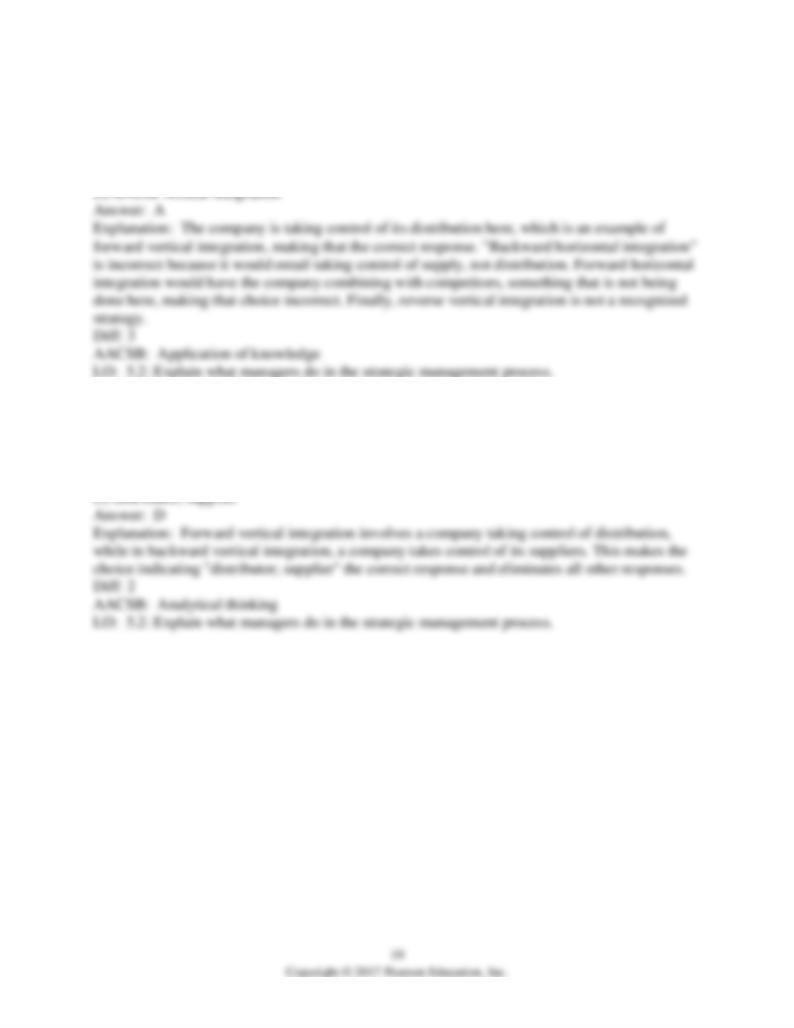
59) A sneaker company creating its own stores where it sells only its own brand is an example of
which of the following?
A) forward vertical integration
B) backward horizontal integration
C) forward horizontal integration
60) In forward vertical integration, a company becomes its own ________, while in backward
vertical integration, the company is its own ________.
A) supplier; distributor
B) supplier; customer
C) distributor; monitor
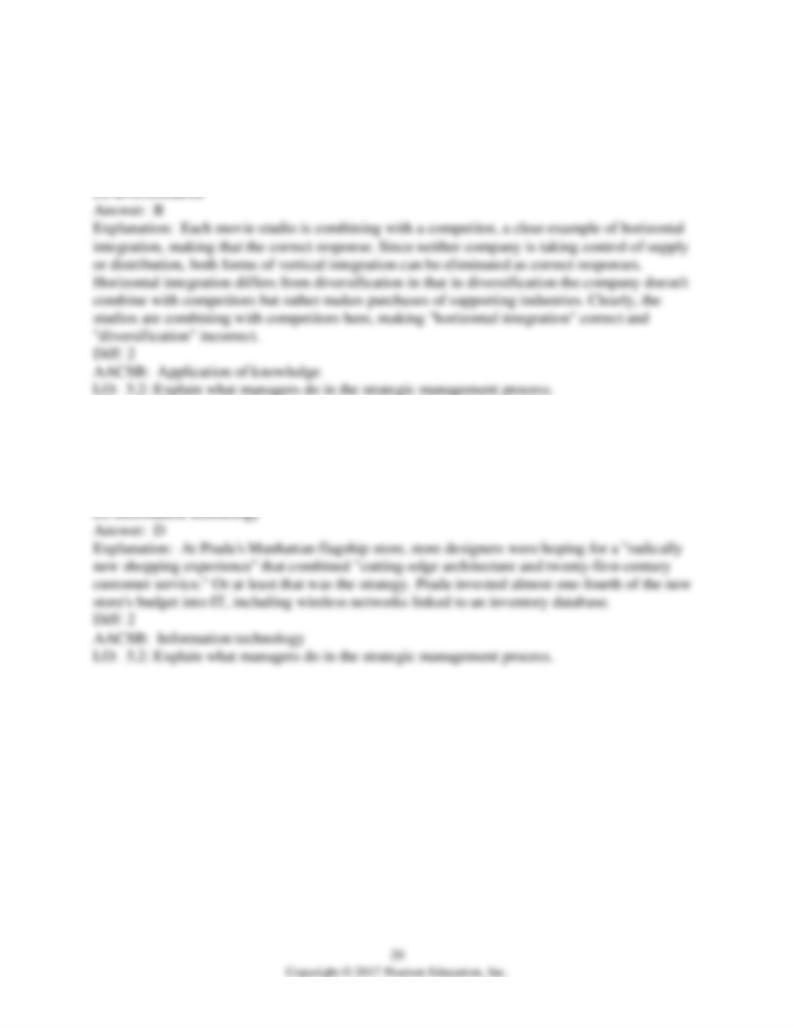
61) Two movie studios combining to form one larger studio is an example of which of the
following?
A) forward vertical integration
B) horizontal integration
C) backward vertical integration
62) Which of the following functional areas has become an important strategic element for
companies such as Prada?
A) customer servicer
B) cost control and accounting
C) human resources
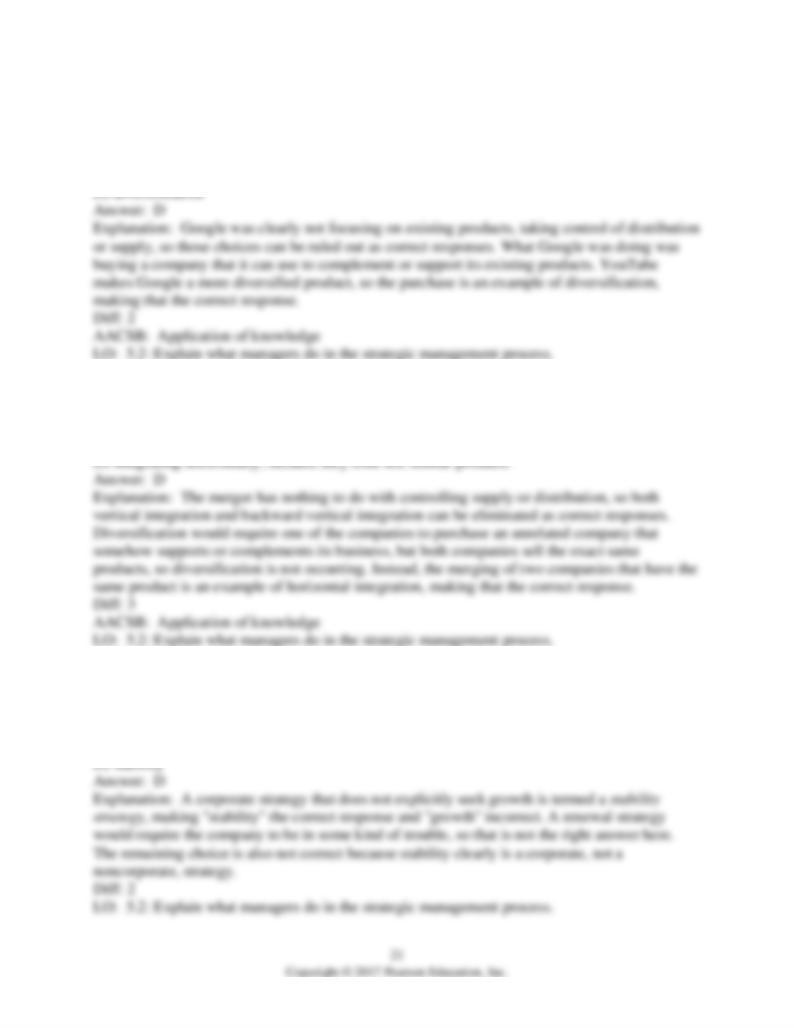
63) When Google purchased YouTube, a company that featured different, but related products,
Google was engaging in which of the following?
A) concentration
B) forward vertical integration
C) backward vertical integration
64) Two companies that both sell fine timepieces combine. What are they doing?
A) diversifying, because they both sell the same products
B) integrating vertically, because they both sell the same products
C) integrating vertically in a backward direction, because they are sharing distribution
65) A company whose goal is to retain its ideal size and market share is employing which kind of
strategy?
A) noncorporate
B) growth
C) renewal

66) Troubled companies seek ________ to address serious problems.
A) competitive strategies
B) corporate strategies
C) vertical and horizontal strategies
67) To address limited, short-term problems, a company is most likely to employ a ________
strategy.
A) retrenchment
B) turnaround
C) doomsday
68) A company that is on the verge of collapse or bankruptcy might employ this strategy.
A) retrenchment
B) incremental improvement
C) turnaround
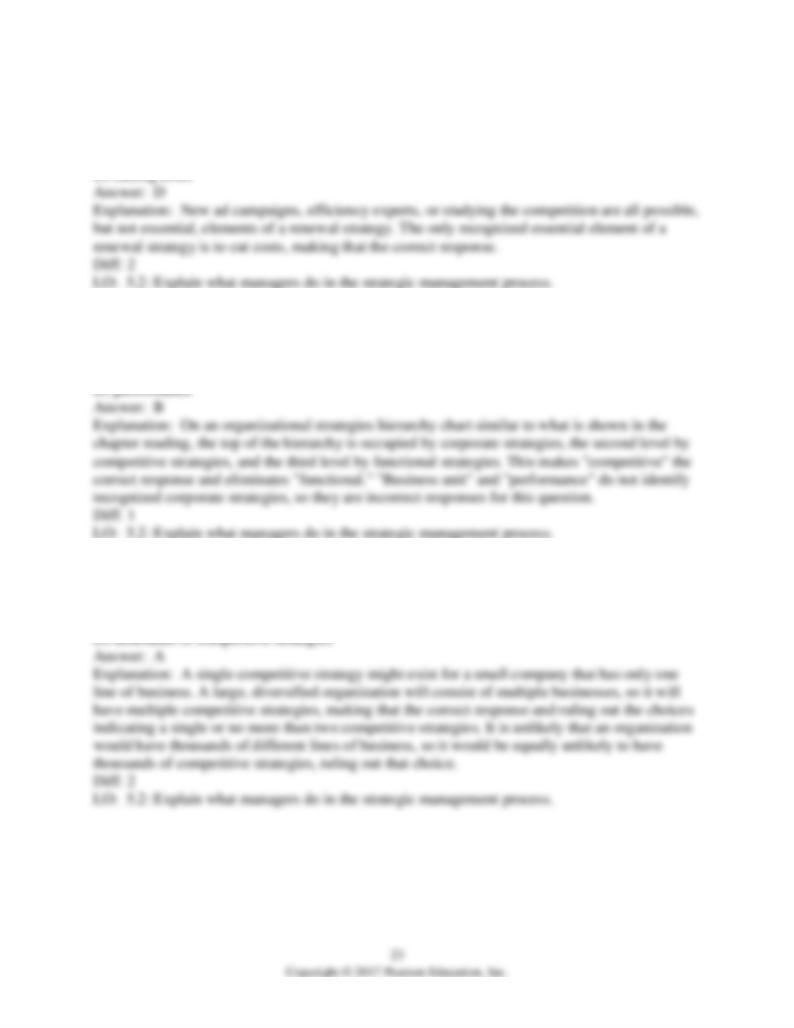
69) Remedies that all renewal strategies employ include which of the following?
A) hiring efficiency experts
B) new ad campaigns
C) emulating competitors
70) The ________ strategy occupies the level below the corporate strategy.
A) business unit
B) competitive
C) functional
71) A diversified corporation is likely to have ________.
A) multiple competitive strategies
B) a single competitive strategy
C) no more than two competitive strategies

72) The thing that makes your product special is known as your ________.
A) assets
B) destruction device
C) competitive advantage
73) Competitive advantages for a high-prestige, premium coffee franchise like Starbucks are
likely to include all of the following EXCEPT ________.
A) high quality
B) lowest prices
C) well-trained employees
74) A cost leadership competitive strategy focuses on which of the following?
A) efficiency
B) innovation
C) elegant design
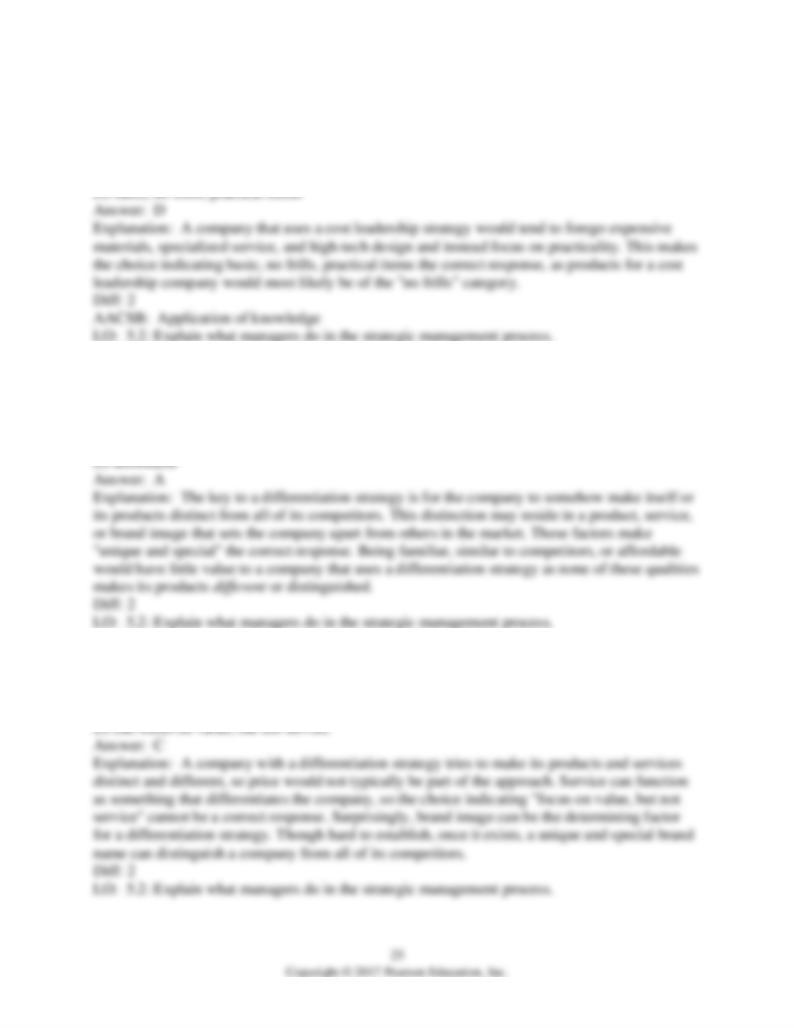
75) Which of the following would you expect to find in a clothing store that follows a cost
leadership strategy?
A) only the finest, most expensive materials
B) pampered, personalized service
C) state-of-the-art design
76) A company with a differentiation strategy focuses on making its products or services
________.
A) unique and special
B) similar to its competitors
C) familiar
77) A differentiation strategy ________.
A) usually focuses on price
B) must focus on price
C) can focus on a brand image
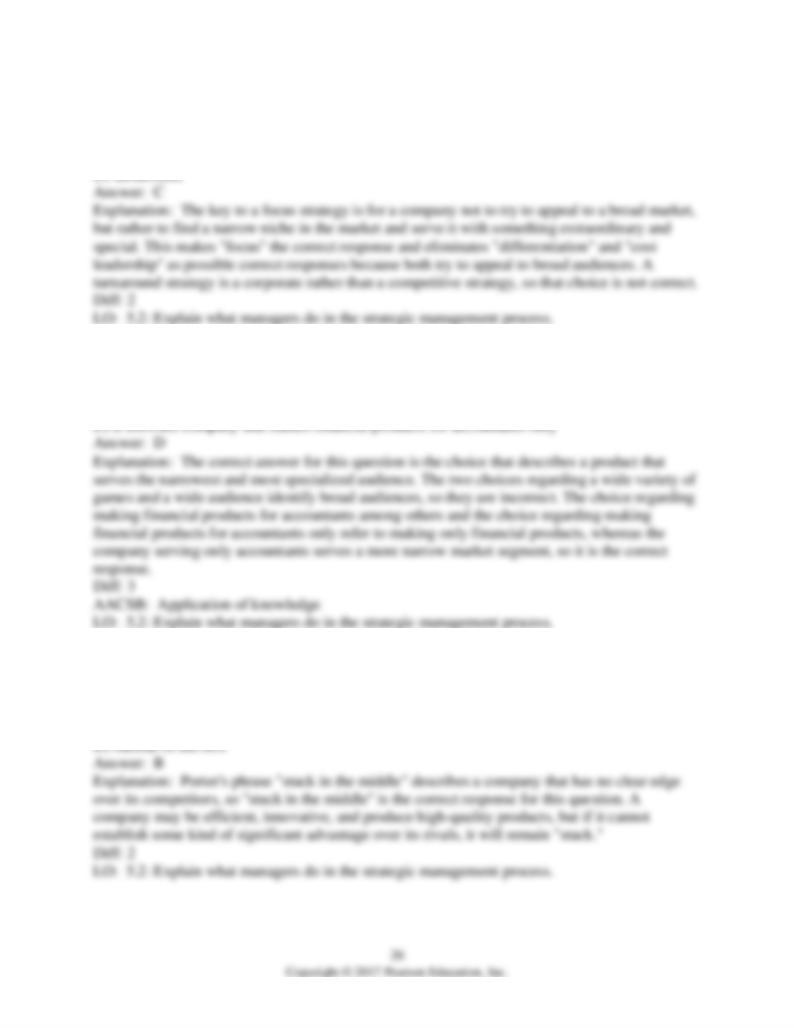
78) A company that looks for a niche in the market is following which strategy?
A) cost leadership
B) differentiation
C) focus
79) Which of the following describes a company that is following a focus strategy?
A) a software company that makes a wide variety of games and financial products
B) a software company that makes games for a wide audience
C) a software company that makes financial products for accountants, consumers, and businesses
80) According to Michael Porter, a company with good products that has no clear competitive
advantage is said to be ________.
A) perfectly positioned
B) stuck in the middle
C) in the wheelhouse
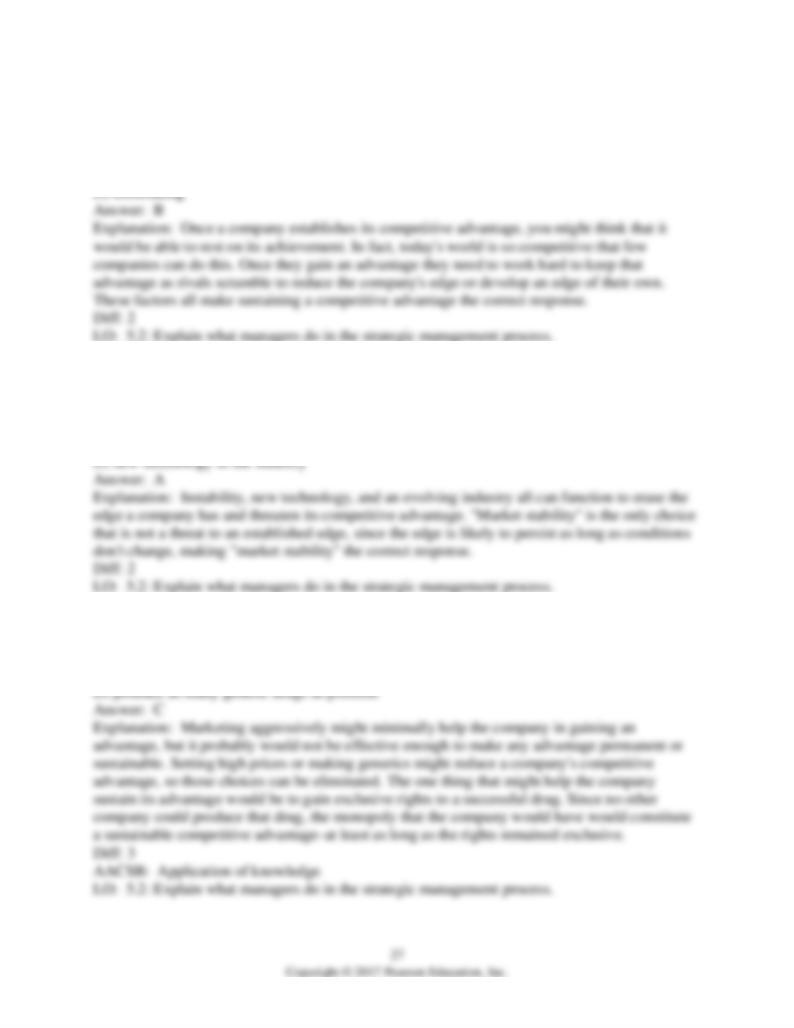
81) Most successful companies find that ________ a competitive advantage is almost as difficult
as developing a competitive advantage.
A) assessing
B) sustaining
C) modifying
82) All of the following are threats to a sustainable, long-term competitive advantage EXCEPT
________.
A) market stability
B) market instabilities and disturbances
C) evolution of the industry
83) To gain a sustainable competitive advantage, a pharmaceutical company might ________.
A) market aggressively
B) set high prices for its products
C) secure exclusive rights to produce a drug
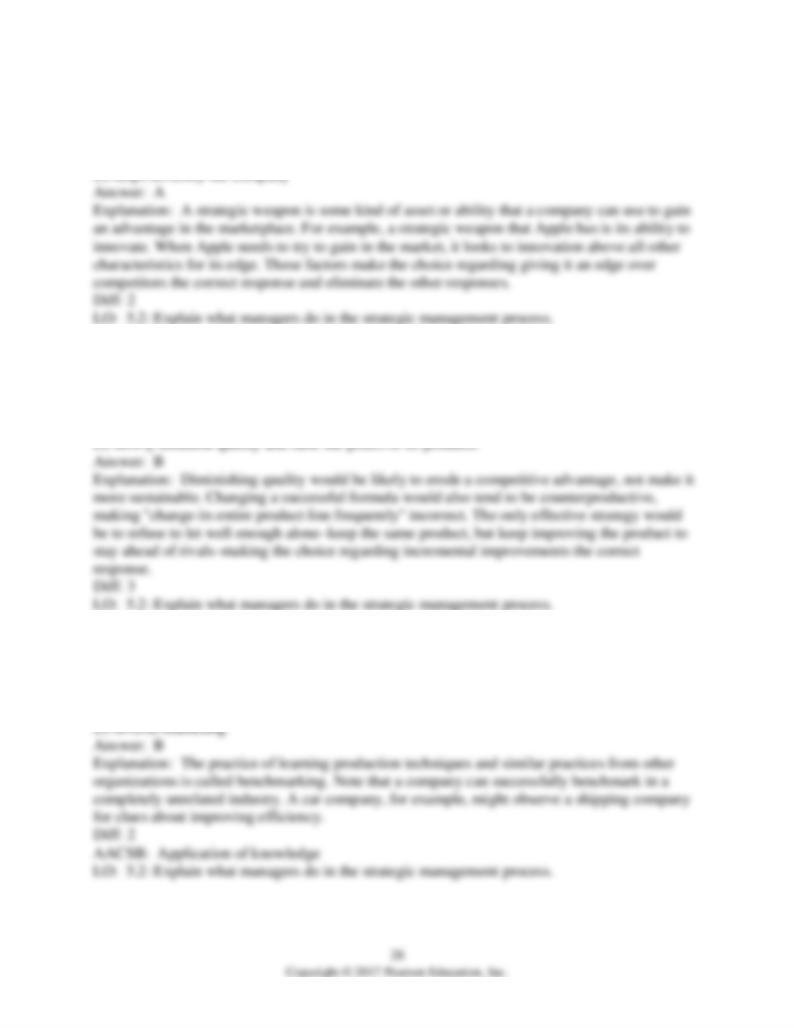
84) A company's strategic weapon is any product, service, or other attribute it has that ________.
A) gives it an edge over its competitors
B) identifies problems that the company has
C) identifies the potential of employees
85) To create a competitive advantage that is sustainable, a company can begin by focusing on
quality, then ________.
A) make sure quality doesn't decline at too rapid a pace
B) make incremental improvements to keep quality levels high
C) change its entire product line frequently
86) This term describes an electric shaver company that carefully observes its competitor's
production line to look for ways to improve its own manufacturing process.
A) trademarking
B) benchmarking
C) quality engineering
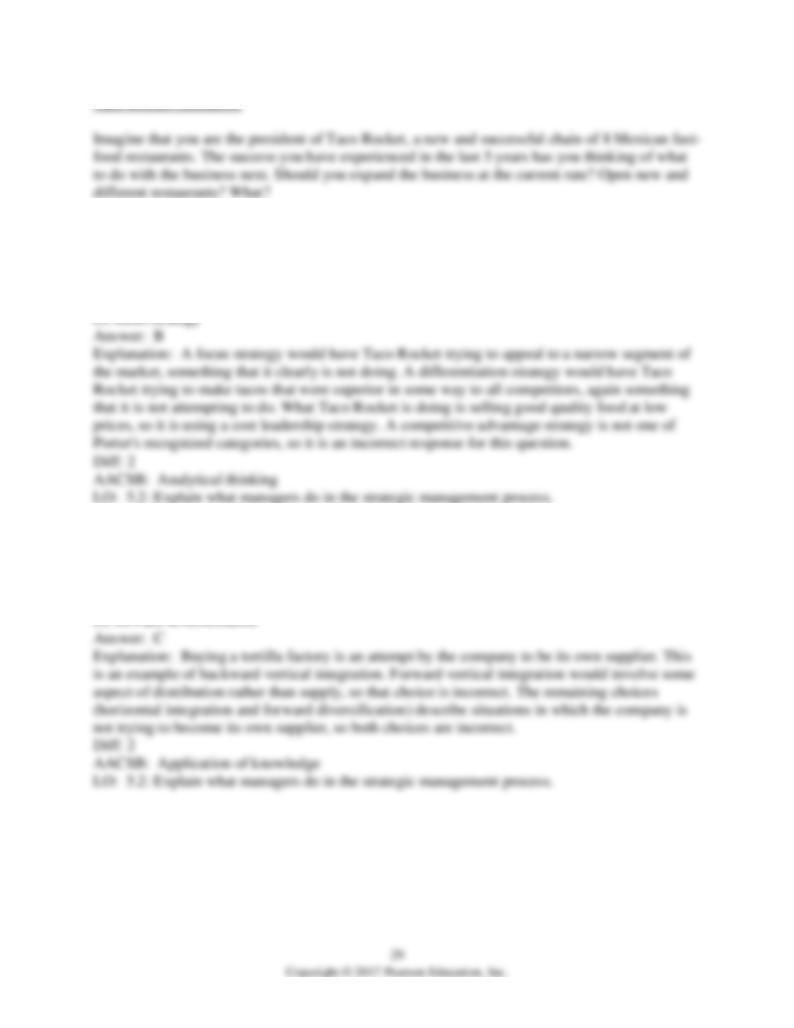
Taco Rocket (Scenario)
87) Up to now your success has been based on selling high-quality tacos and burritos at a price
that others can't match. Your business is pursuing which of Porter's strategies?
A) differentiation strategy
B) cost leadership strategy
C) competitive advantage strategy
88) You are thinking of buying a tortilla factory in a nearby state. This action would be an
example of ________.
A) forward vertical integration
B) horizontal integration
C) backward vertical integration
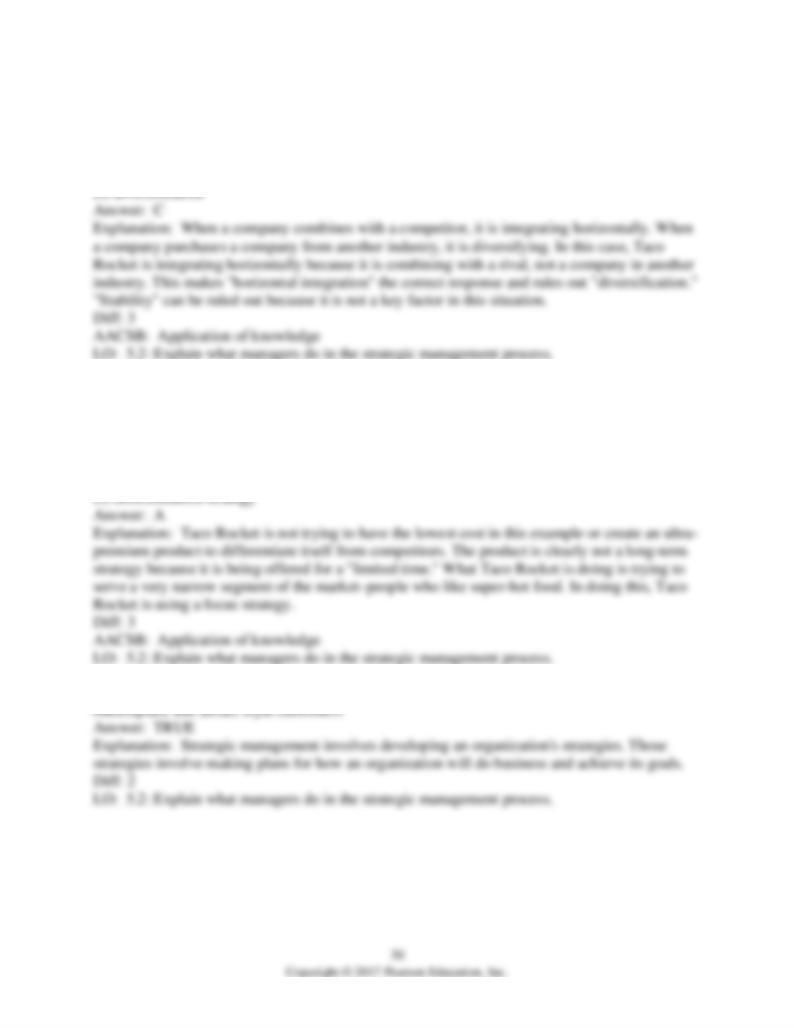
89) Recently, Taco Rocket has considered buying a local competitor and the two would combine
under the Taco Rocket name. This is an example of which of the following?
A) stability
B) vertical integration
C) horizontal integration
90) For a limited time, Taco Rocket is thinking of coming out with a new Fifth Degree Burrito
that is so hot it "burns a hole in the plate." Catering to the small segment of the market that likes
super-hot food is an example of a ________.
A) focus strategy
B) cost leader strategy
C) long-term strategy
91) Strategic management is the act of figuring out how an organization will compete in the
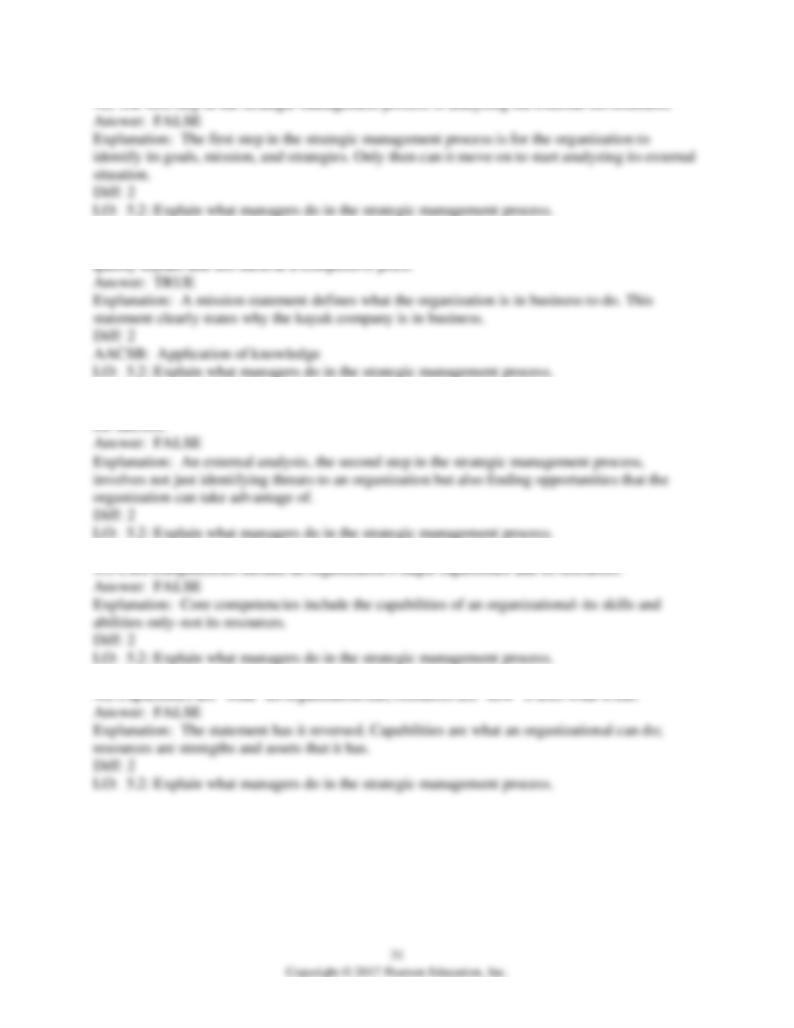
93) A mission statement for a kayak manufacturer might be as follows: To make the highest-
94) An external analysis will identify the threats to a company's well-being, but not opportunities
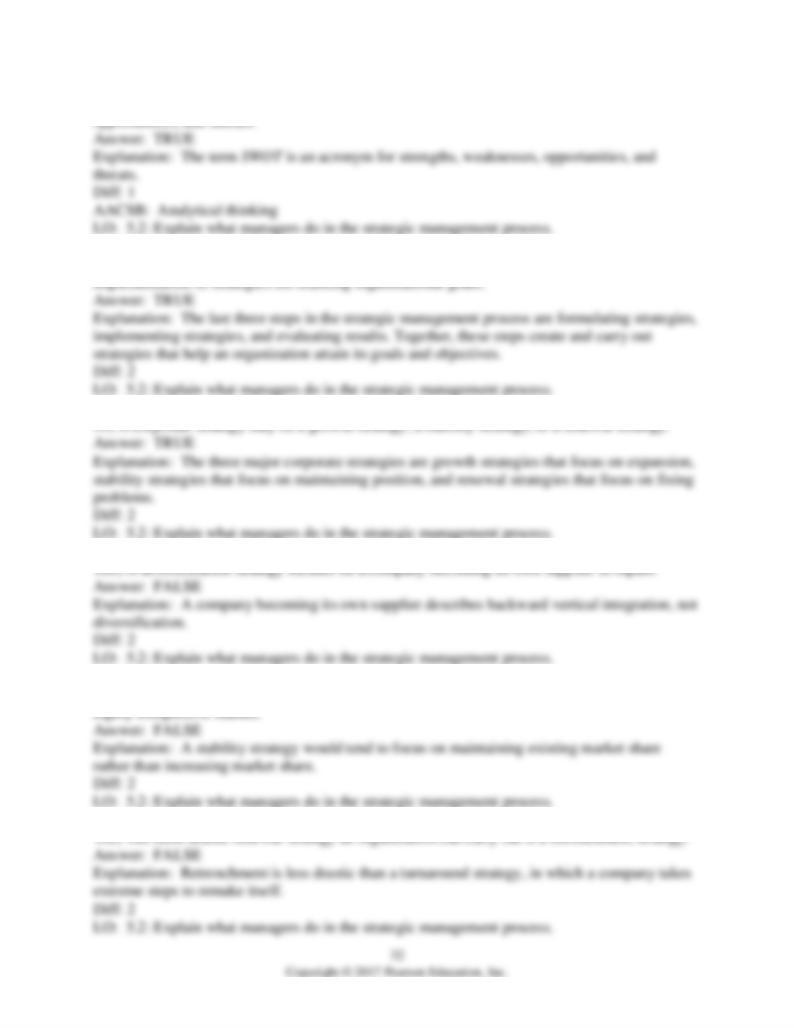
97) SWOT analysis includes the identification of an organization's strengths, weaknesses,
98) The final three steps in the strategic management process involve the creation and
101) A company with a stability strategy will plan to dramatically increase market share in a
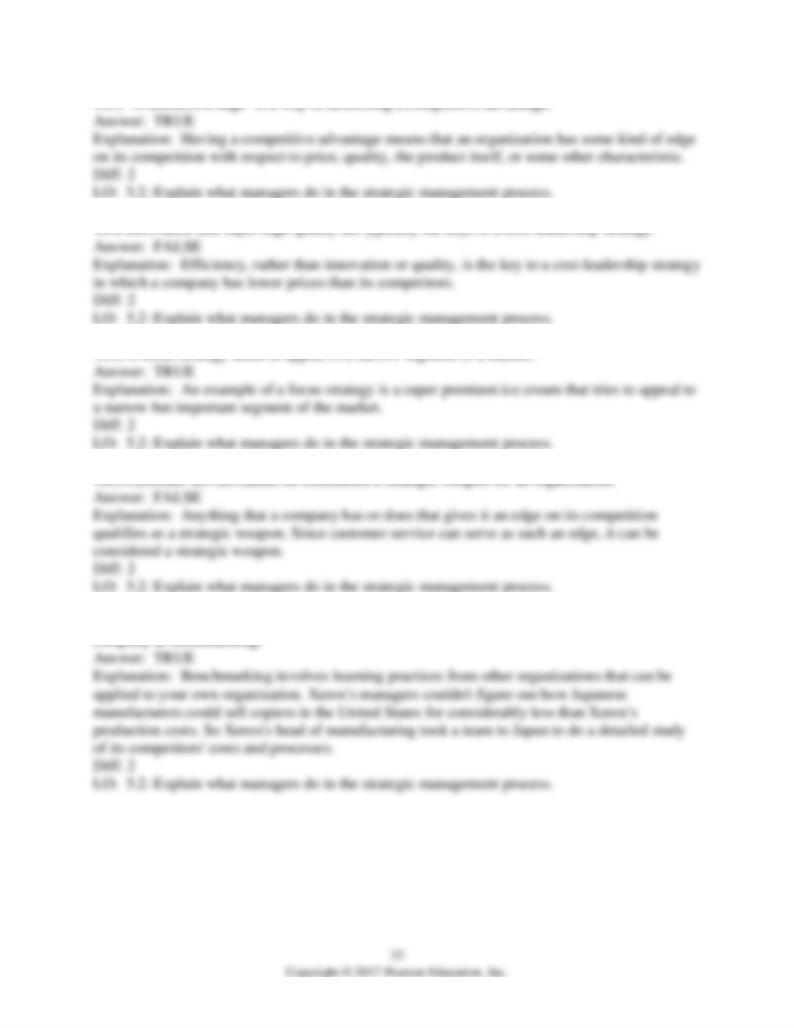
107) Xerox Corporation's study of Japanese competitors was the first effort by an American
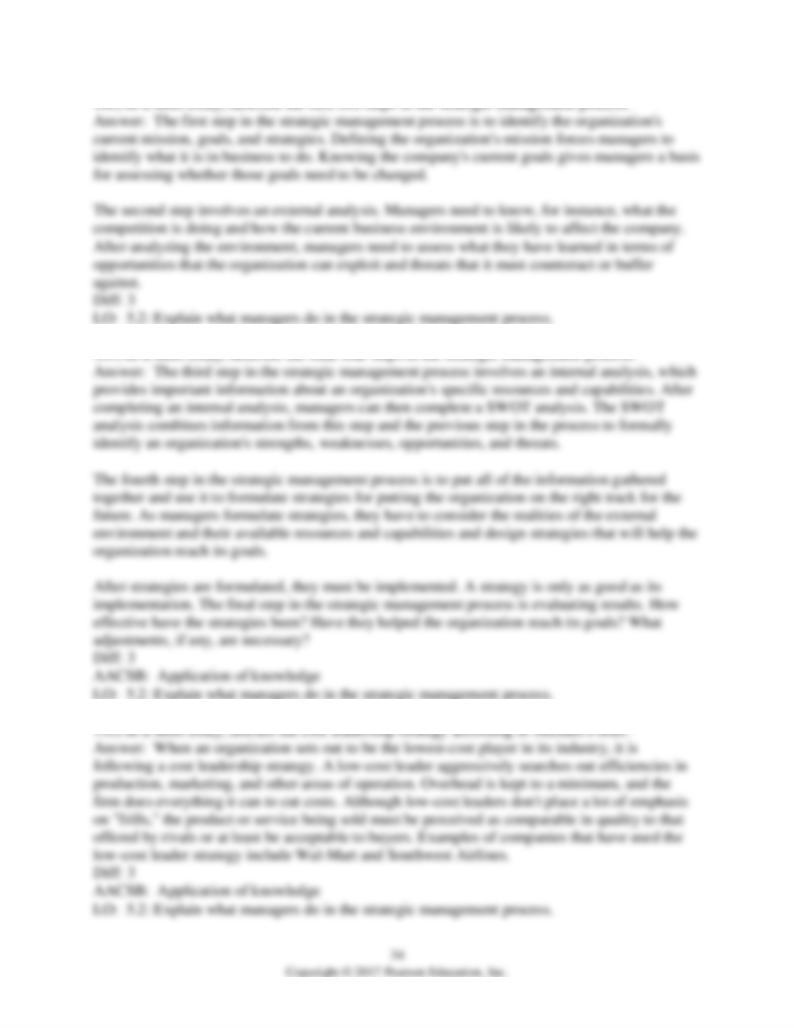

113) Which of the following best defines plans?
A) documents that identify company problems
B) documents that define goals
C) documents that describe how goals will be met
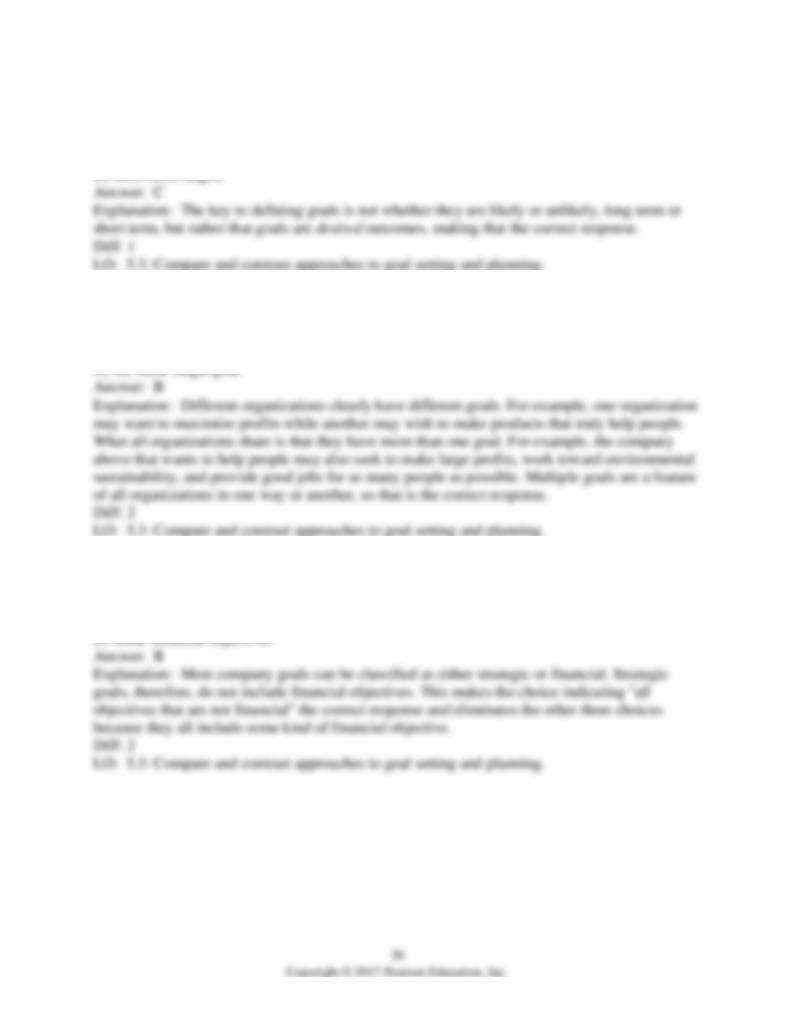
114) Which of the following best defines goals?
A) likely outcomes for the future
B) unlikely outcomes for the future
C) desired outcomes for the future
115) In reality, all organizations have ________.
A) a single goal
B) multiple goals
C) the same goals
116) In most cases, strategic goals include ________.
A) all financial objectives
B) all objectives that are not financial
C) all objectives, both financial and nonfinancial
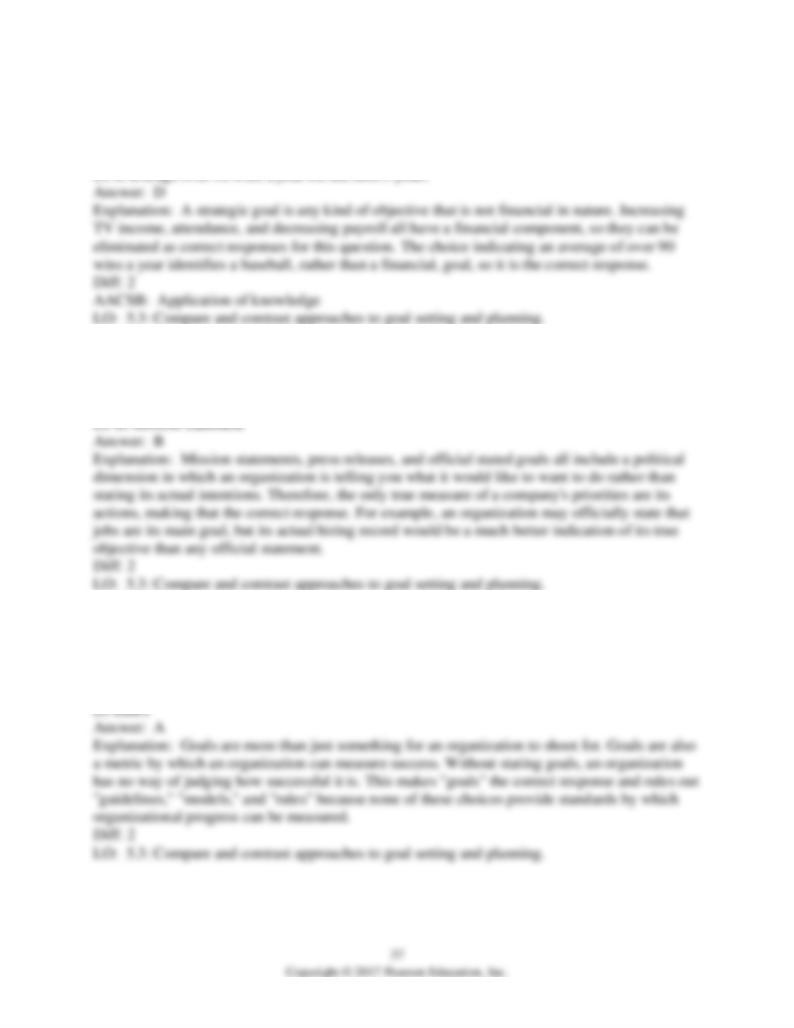
117) Which of the following is an example of a strategic goal for a professional baseball team?
A) to increase attendance by 5 percent over the next three years
B) to increase television revenues over the next 5 years
C) to decrease payroll by 20 million over the next 2 years
118) An organization's real goals and priorities are best revealed by ________.
A) its official stated goals
B) its actions in the marketplace
C) its statements to the press
119) ________ are important because they provide the standards against which all organizational
accomplishments are measured.
A) Goals
B) Guidelines
C) Models
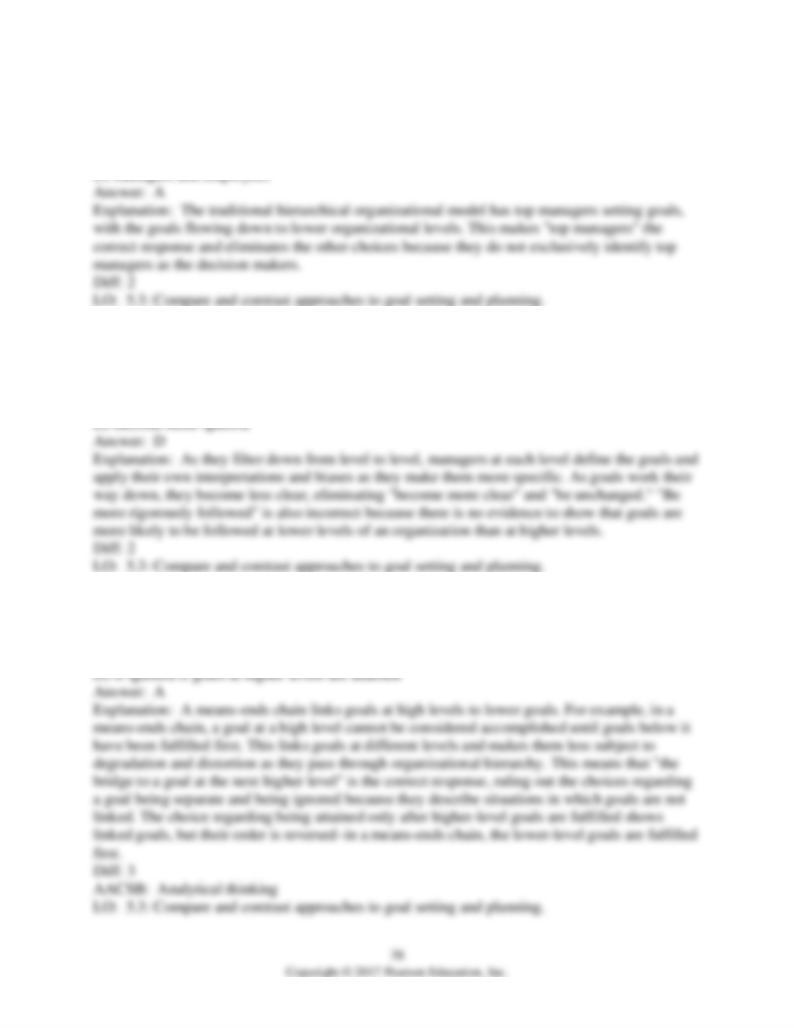
120) In traditional goal setting, these individuals set goals.
A) top managers
B) middle and low-level managers
C) middle managers
121) In traditional goal setting, as they work their way from top management to employees,
goals are likely to ________.
A) become more clear
B) be more rigorously followed
C) be unchanged
122) In a means-ends chain, a goal at a lower level ________.
A) is the bridge to a goal at the next higher level
B) is attained only after higher level goals are fulfilled
C) is separate from the goal at the next higher level
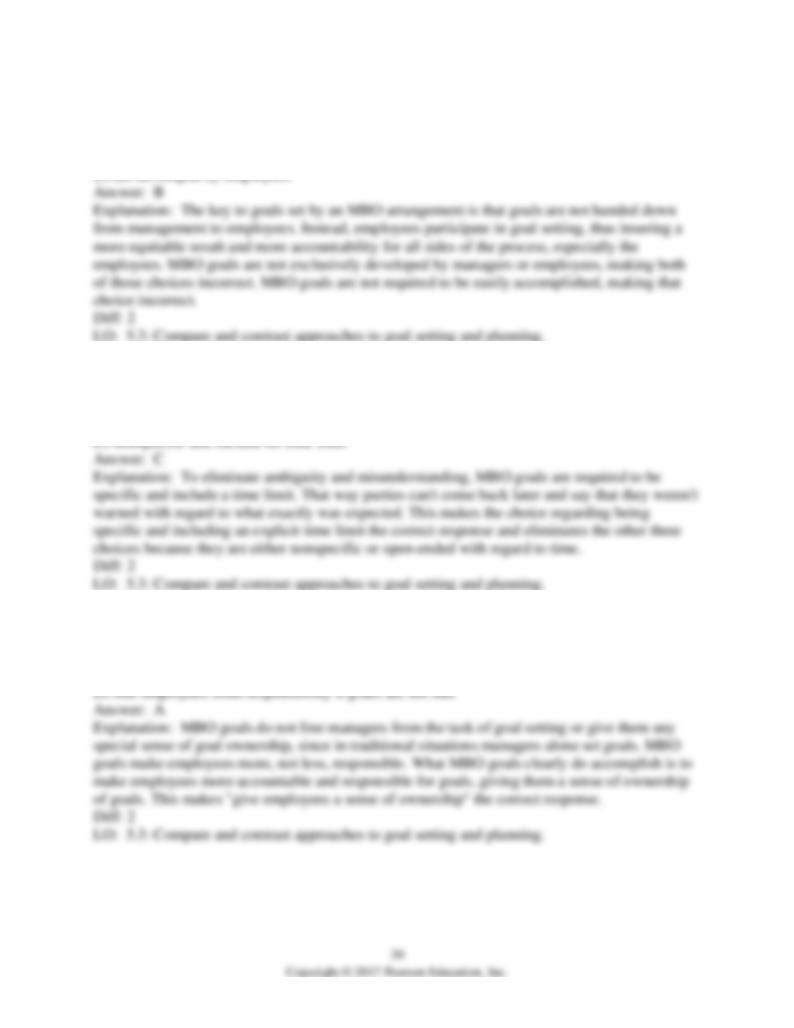
123) In management by objectives (MBO), goals ________.
A) must be easily accomplished
B) are jointly determined by employees and managers
C) are determined by top management
124) In addition to being made by both managers and employees, MBO goals must be ________.
A) nonspecific and open-ended with regard to time
B) specific and open-ended with regard to time
C) specific and include an explicit time limit
125) MBO programs usually are successful largely because they ________.
A) give employees a sense of ownership of goals
B) free managers from the responsibility of setting goals
C) give managers a sense of ownership of goals

126) Which goal-setting sequence is correct for the following steps?
1. Evaluate resources.
2. Identify goals.
3. Review the mission and job tasks.
4. Communicate goals.
5. Link rewards to goals.
6. Build feedback mechanisms.
A) 1, 2, 4, 6, 3, 5
B) 4, 2, 5, 3, 1, 6
C) 3, 4, 2, 6, 5, 1
127) The breadth of a plan refers to ________ concerns.
A) long-term versus short-term
B) strategic versus tactical
C) specific versus directional
128) The specificity of a plan refers to ________ concerns.
A) long-term versus short-term
B) strategic versus tactical
C) specific versus directional
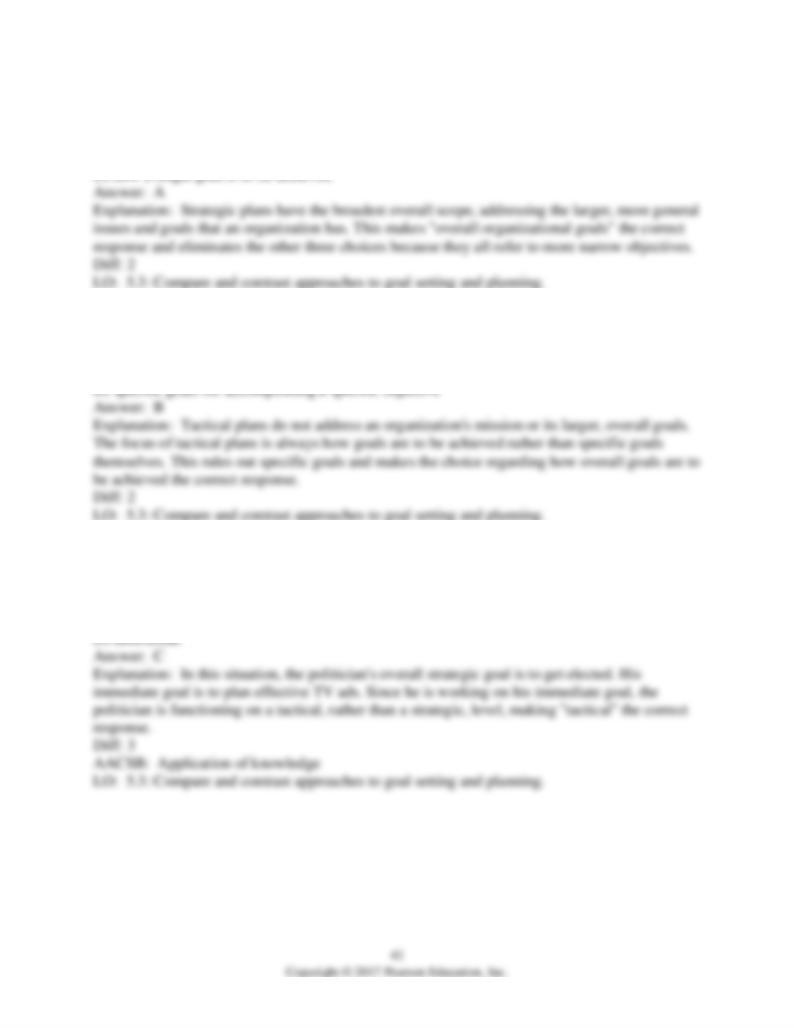
129) Strategic plans address ________.
A) overall organizational goals
B) goals for a single branch of the organization
C) how overall goals are to be achieved
130) Tactical plans are operational plans that identify ________.
A) overall organizational goals
B) how overall goals are to be achieved
C) the mission of an organization
131) A politician whose ultimate goal is to get elected is planning campaign ads for TV. In
planning the ads, the politician is functioning at a ________ level.
A) strategic
B) long-term
C) tactical

132) Which of the following defines the time frame of a long-term plan?
A) over seven years
B) over three years
C) under three years
133) Directional plans ________.
A) leave no room for interpretation
B) are flexible general guidelines
C) are difficult to modify
134) Standing plans typically can be used ________.
A) only once
B) only in conjunction with specific, long-term plans
C) twice at most
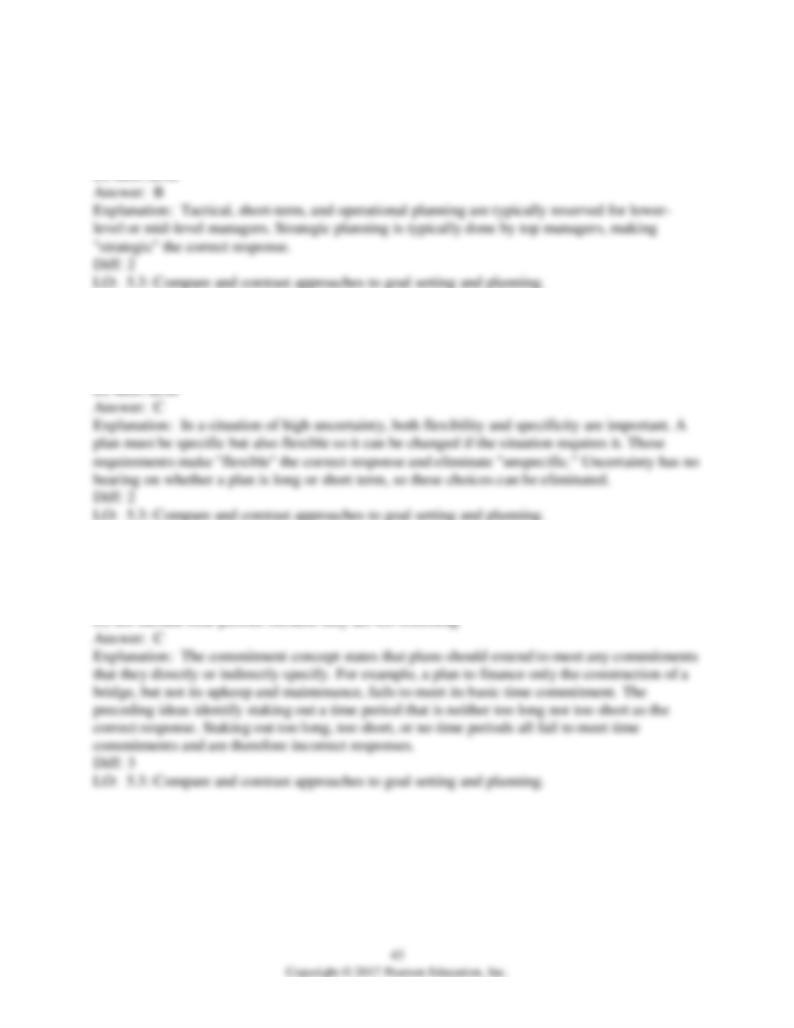
135) Top managers, for the most part, focus on this type of planning.
A) operational
B) strategic
C) tactical
136) The more uncertain a situation is, the more ________ plans must be.
A) unspecific
B) long term
C) flexible
137) The commitment concept states that plans should ________.
A) always stake out a longer time period than is estimated
B) always stake out a shorter time period than is estimated
C) stake out a time period that is neither too long nor too short
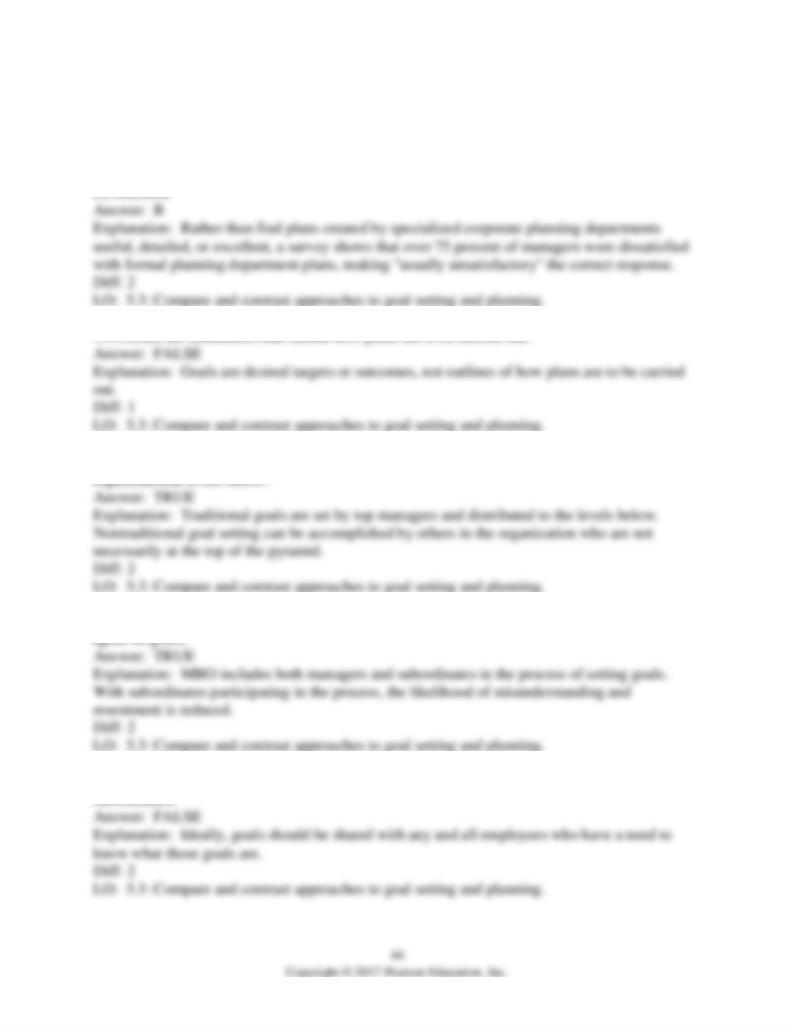
138) Most managers feel that formal, top-down plans created by corporate planning departments
are ________.
A) very useful
B) usually unsatisfactory
C) very detailed
140) Traditional goal setting requires top managers to set goals that are carried out by the
141) The key to MBO, or management by objectives, is that managers and subordinates mutually
142) Goals typically should be reserved for managers only. Goals should not be shared with
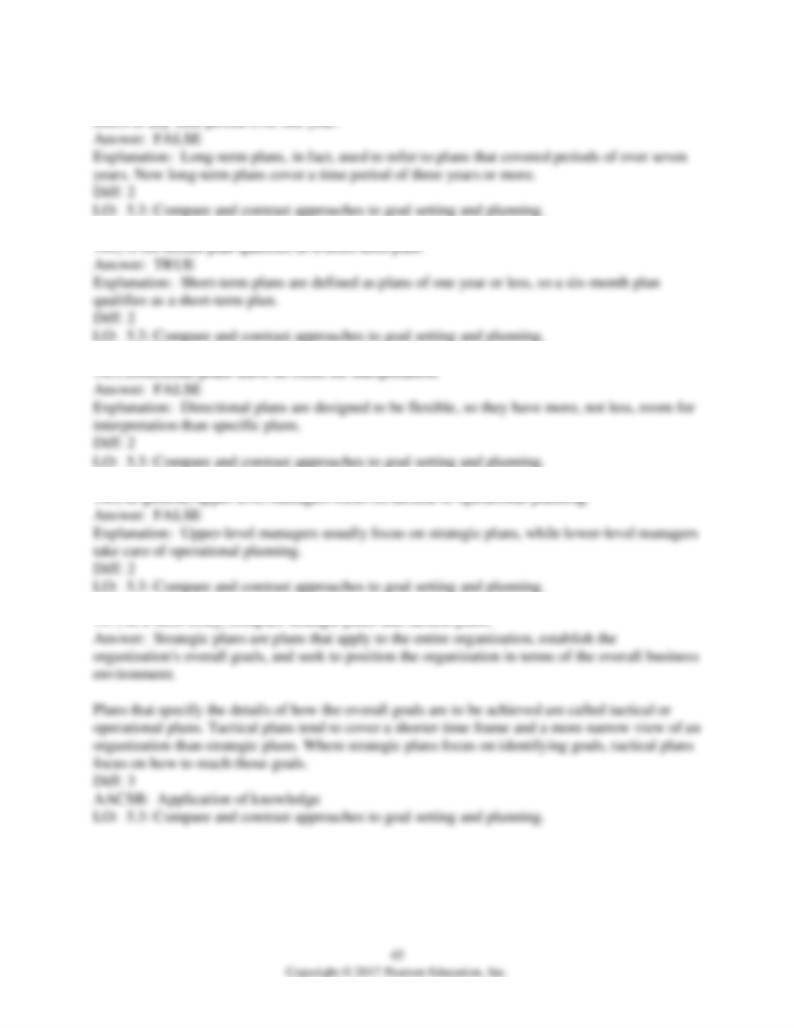
143) Long-term plans used to refer to plans that covered a period of over three years, but now it
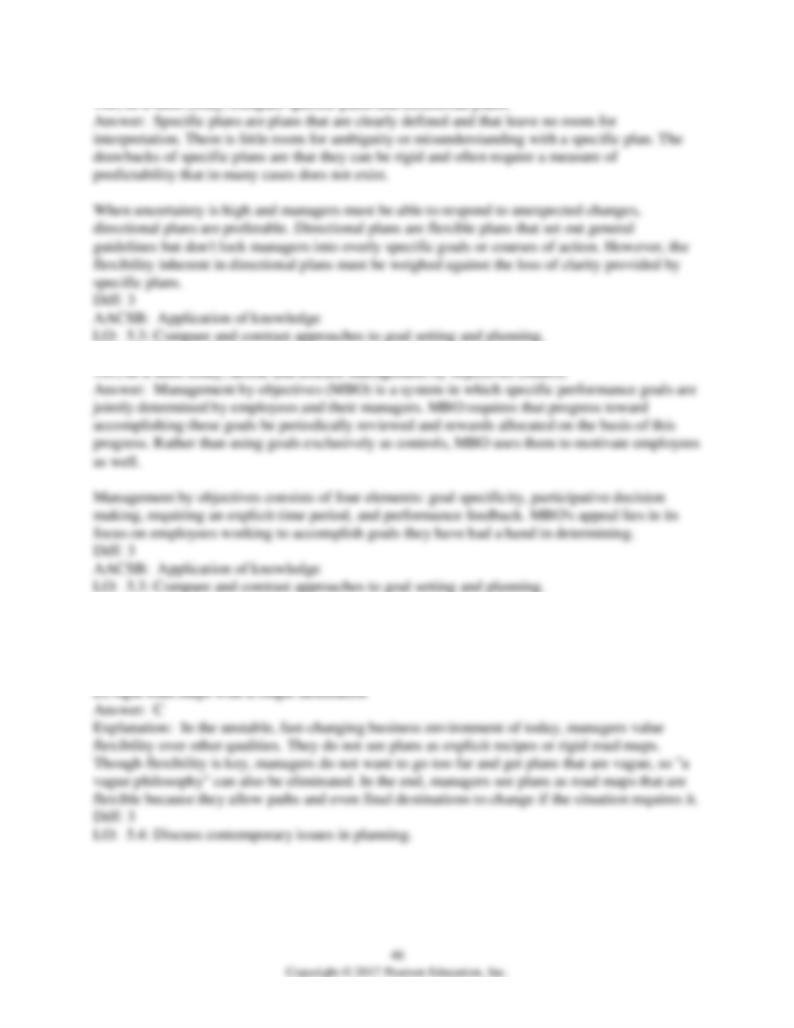
150) In the twenty-first century, managers increasingly need to consider their plans as ________.
A) highly explicit recipes that must be scrupulously followed
B) a vague philosophy that should not interfere with actions
C) flexible road maps with destinations that may change
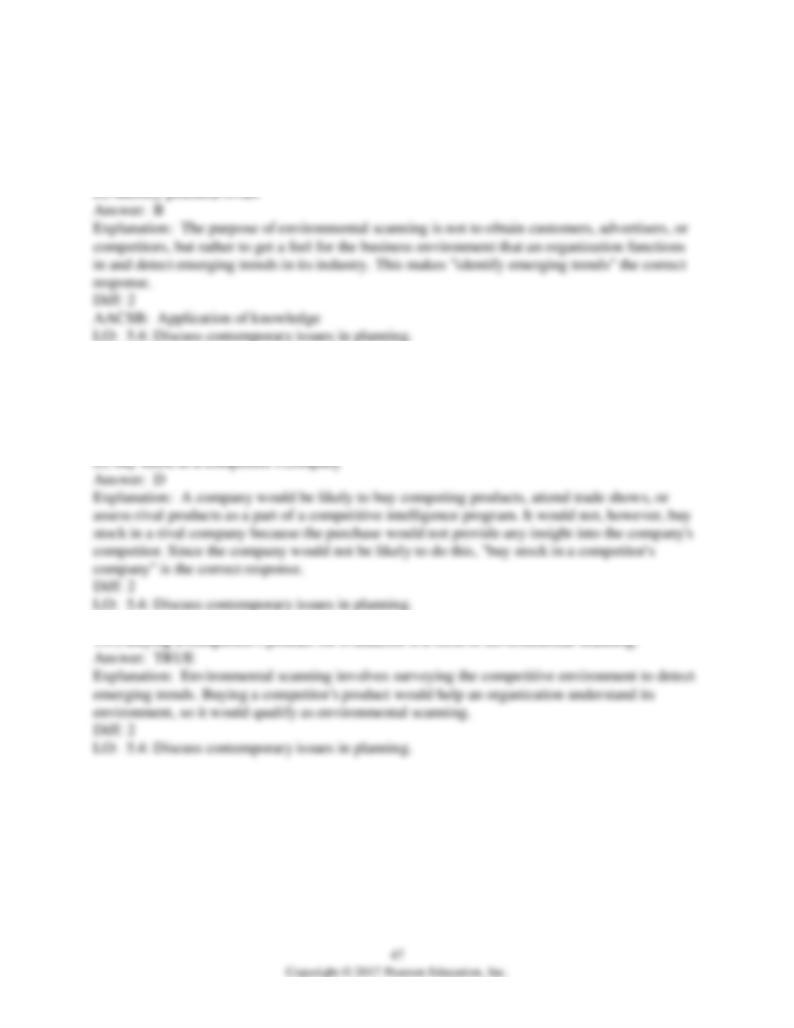
151) A cell phone company might ask managers to do some environmental scanning of blogs
that deal with electronics as a way to ________.
A) obtain new customers
B) identify emerging trends
C) obtain new advertisers
152) Which of the following is NOT something that a company would be likely to do as a part of
a competitive intelligence program?
A) buy competitors' products
B) attend trade shows
C) have employees evaluate competing products
